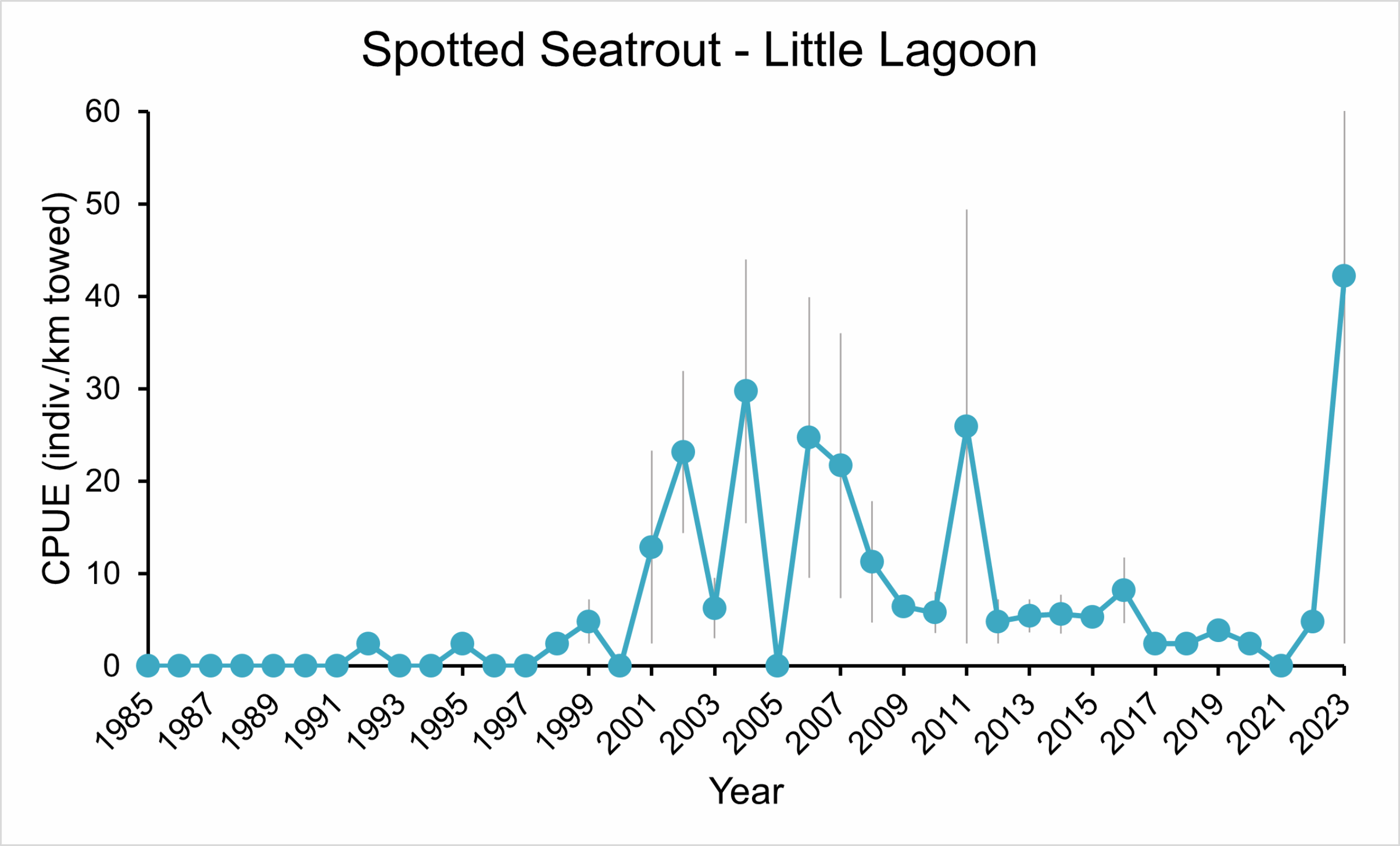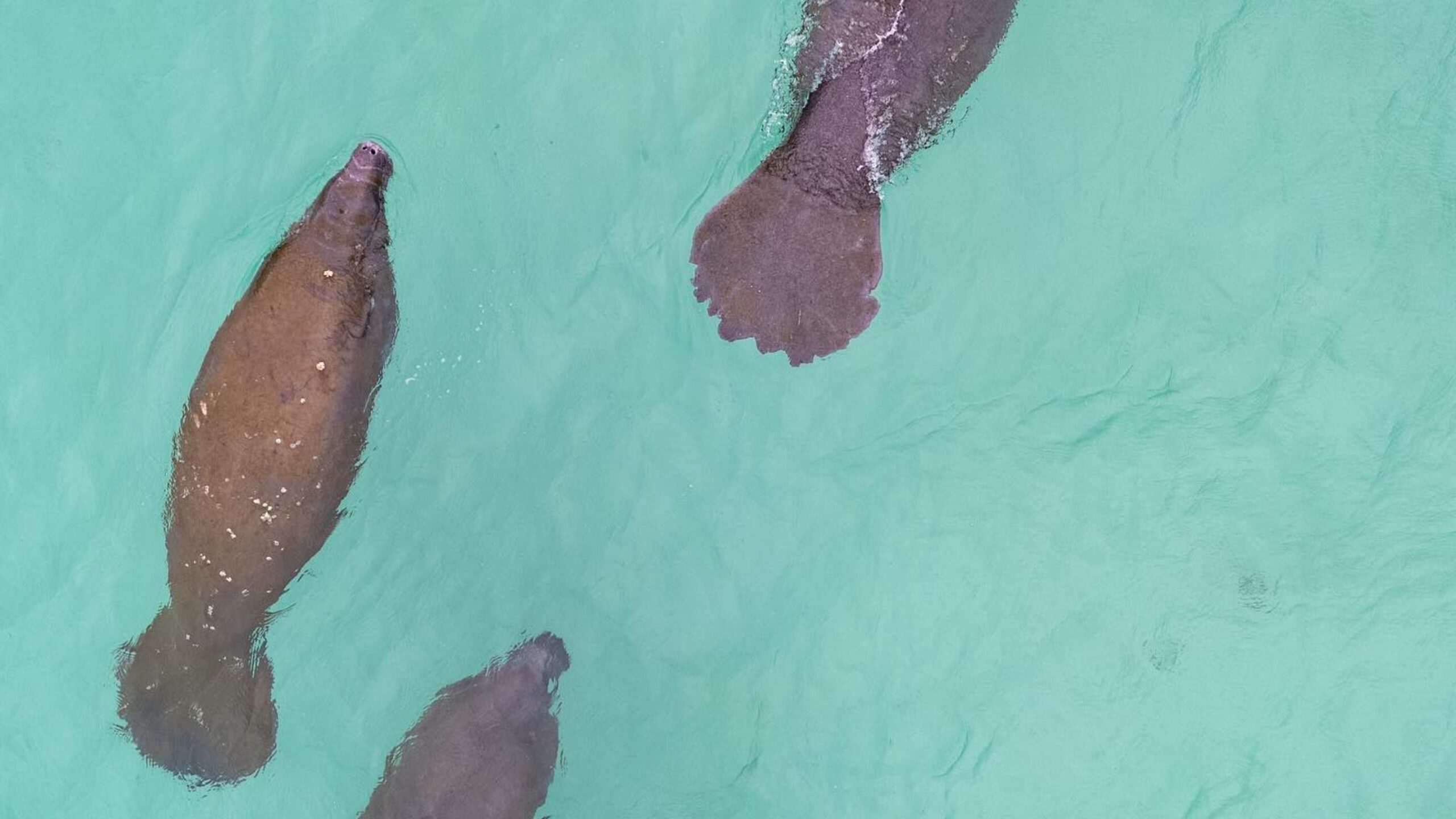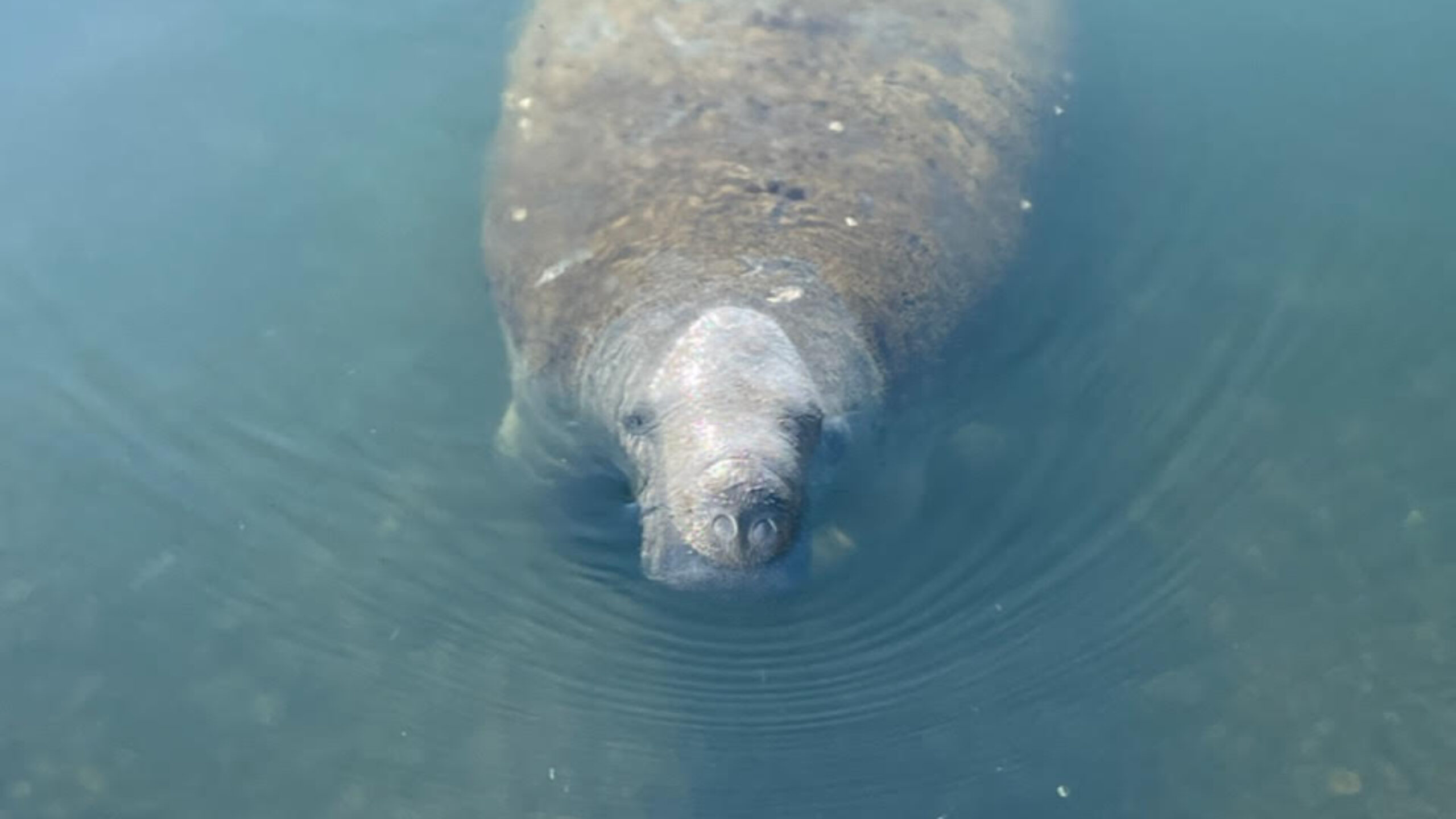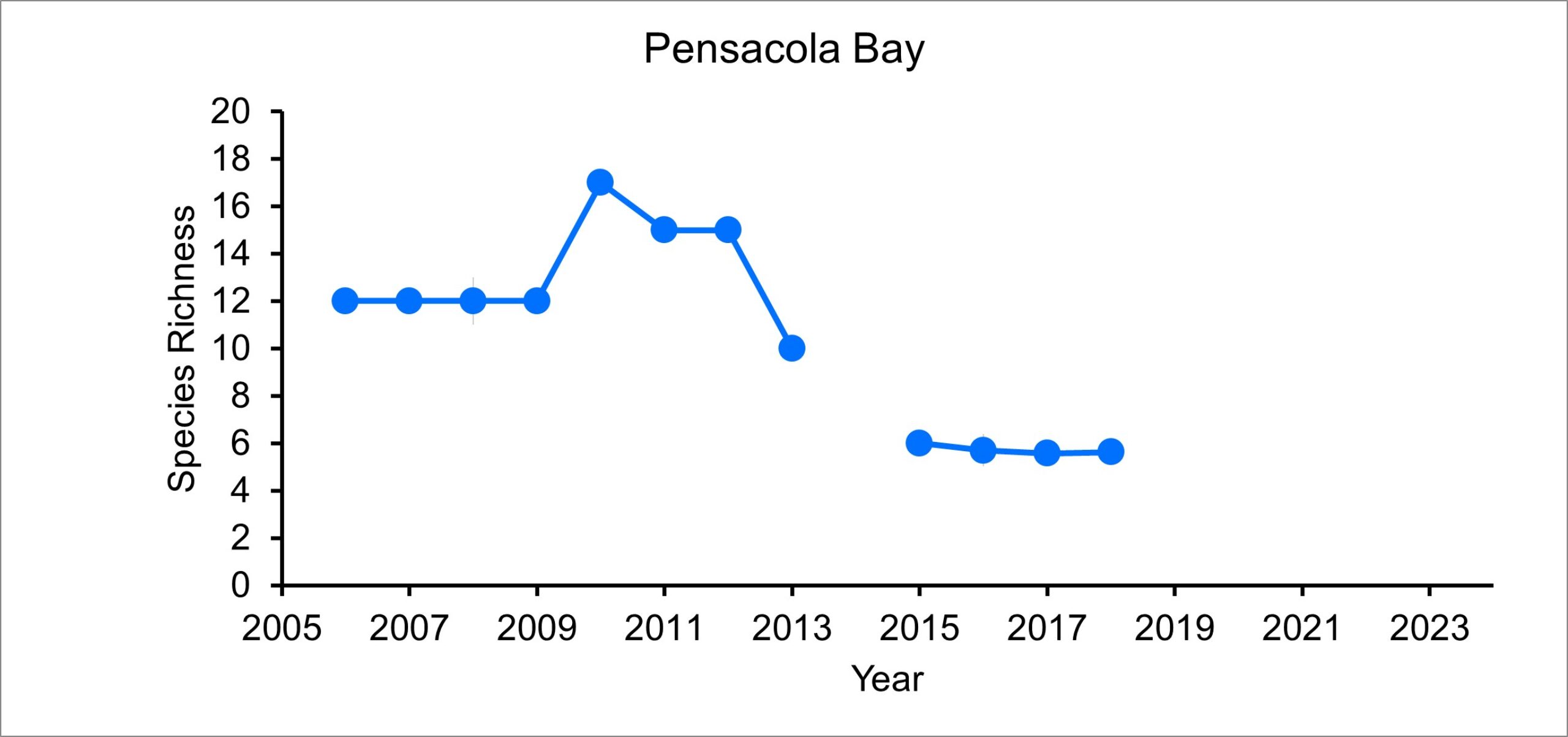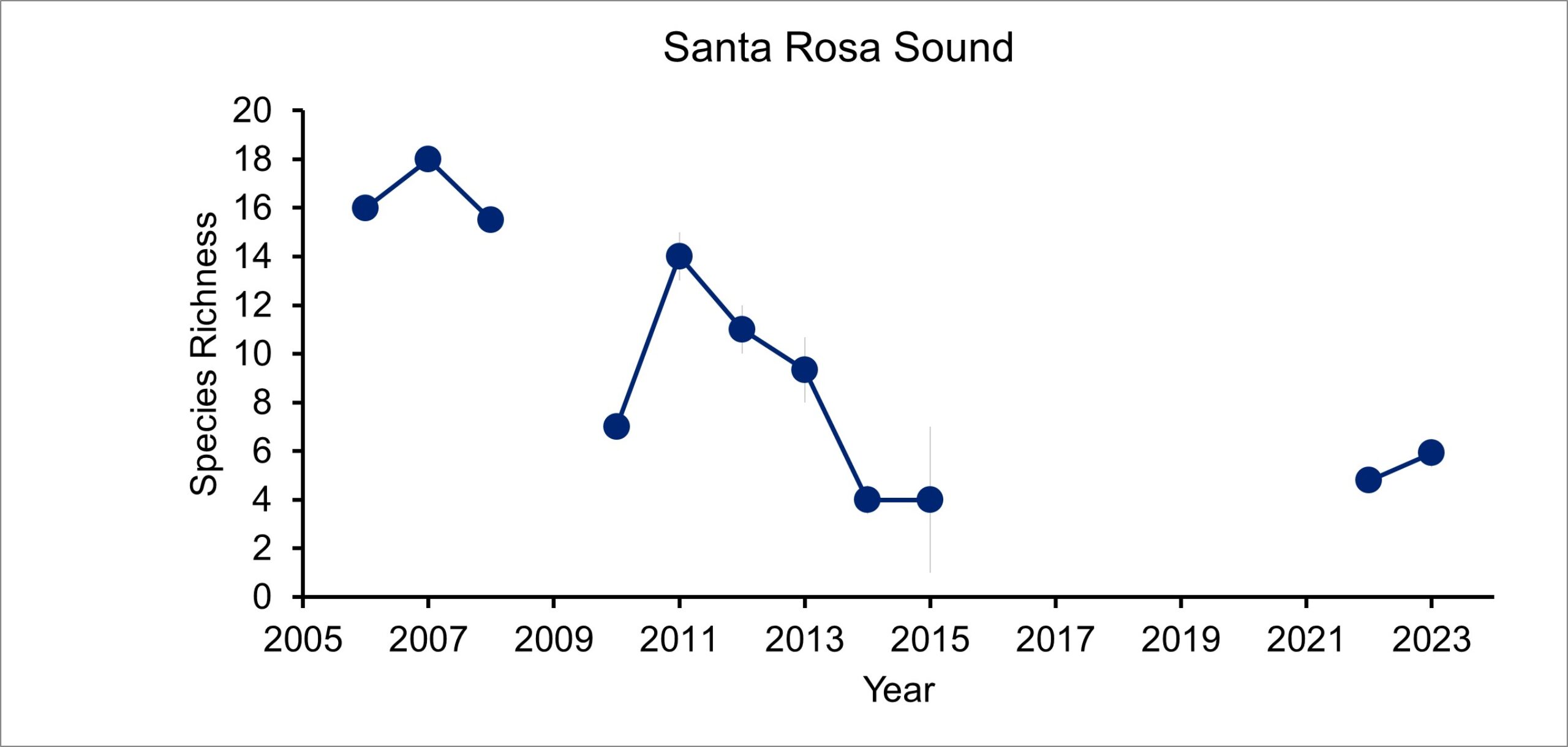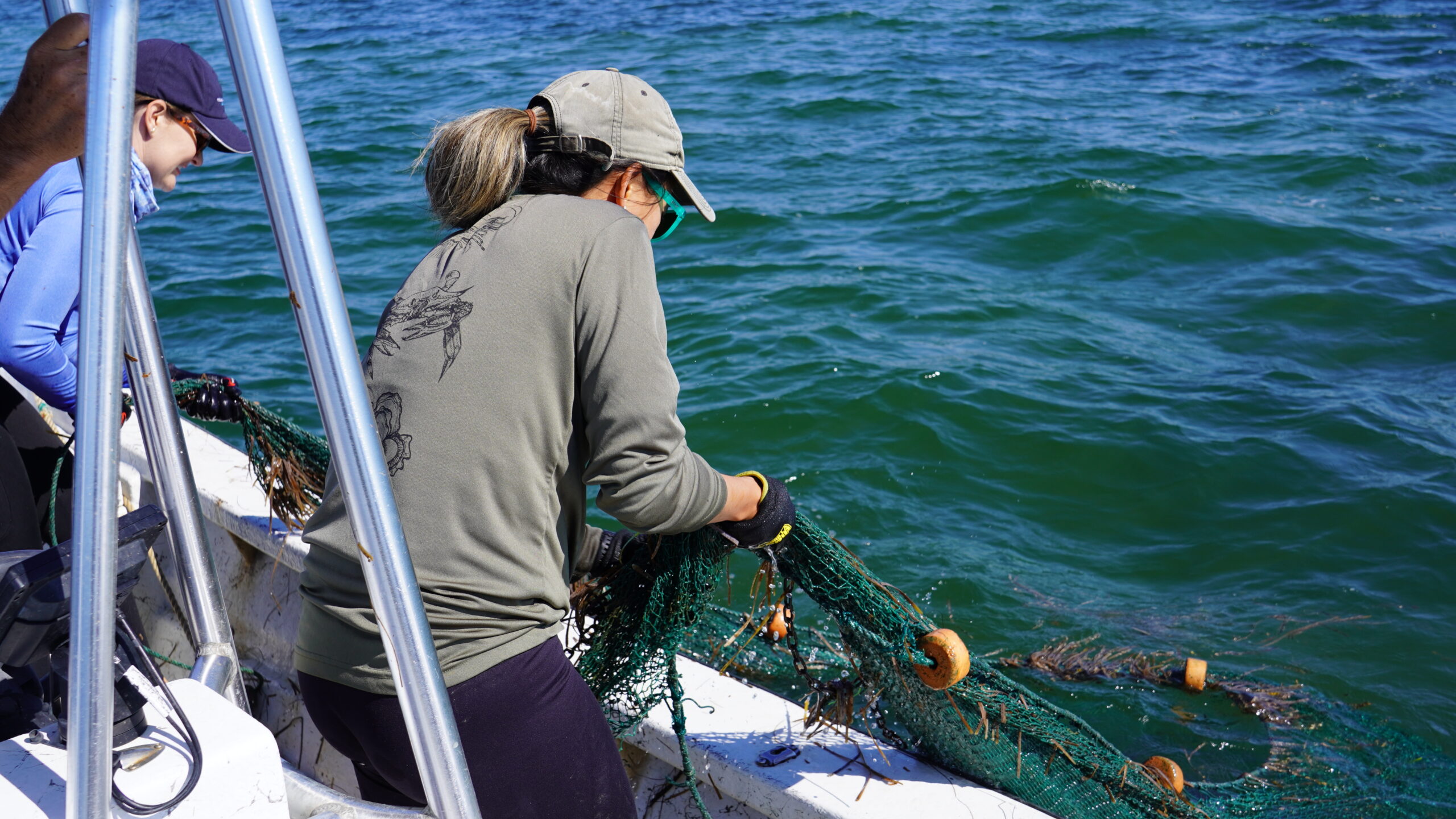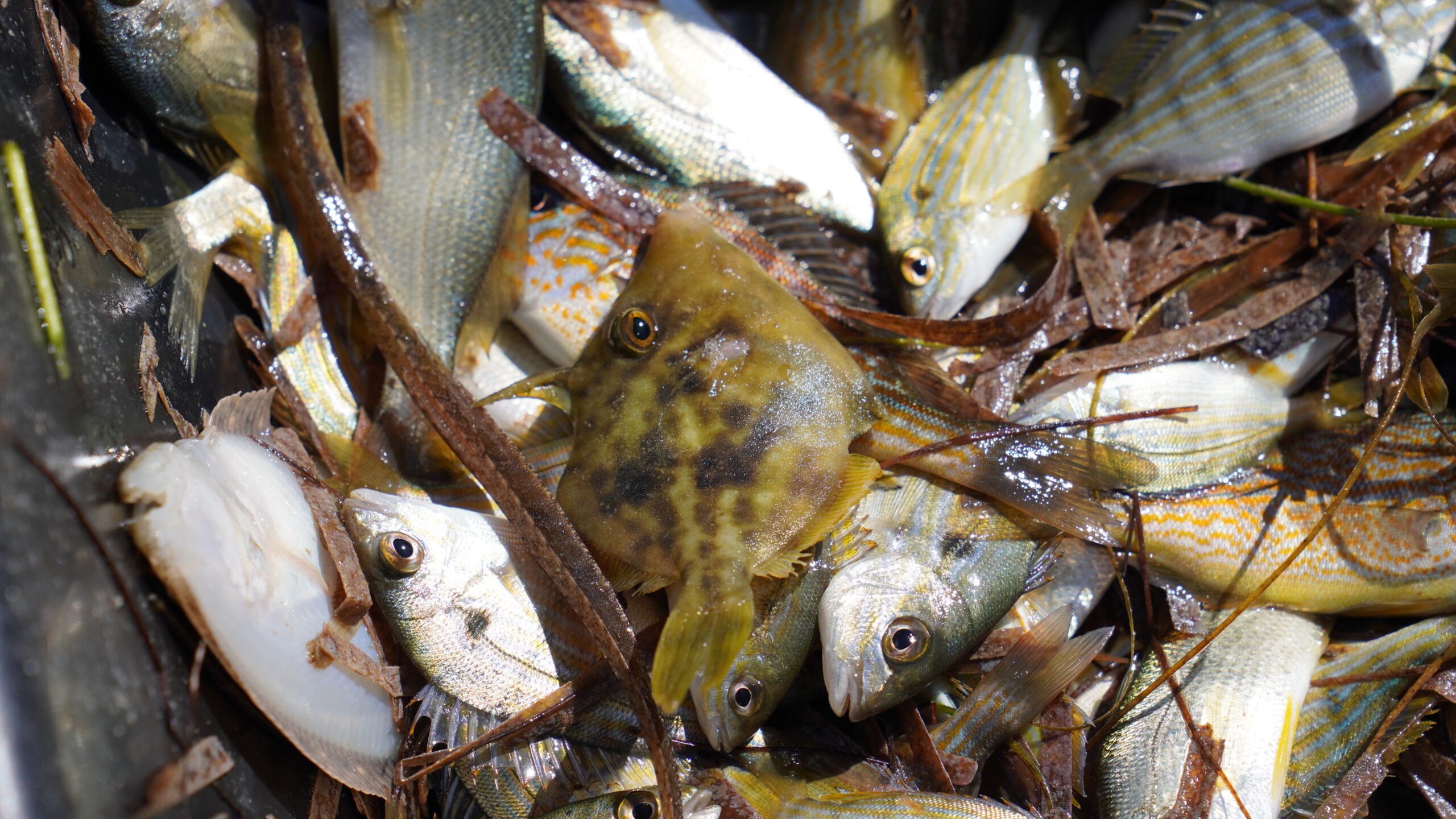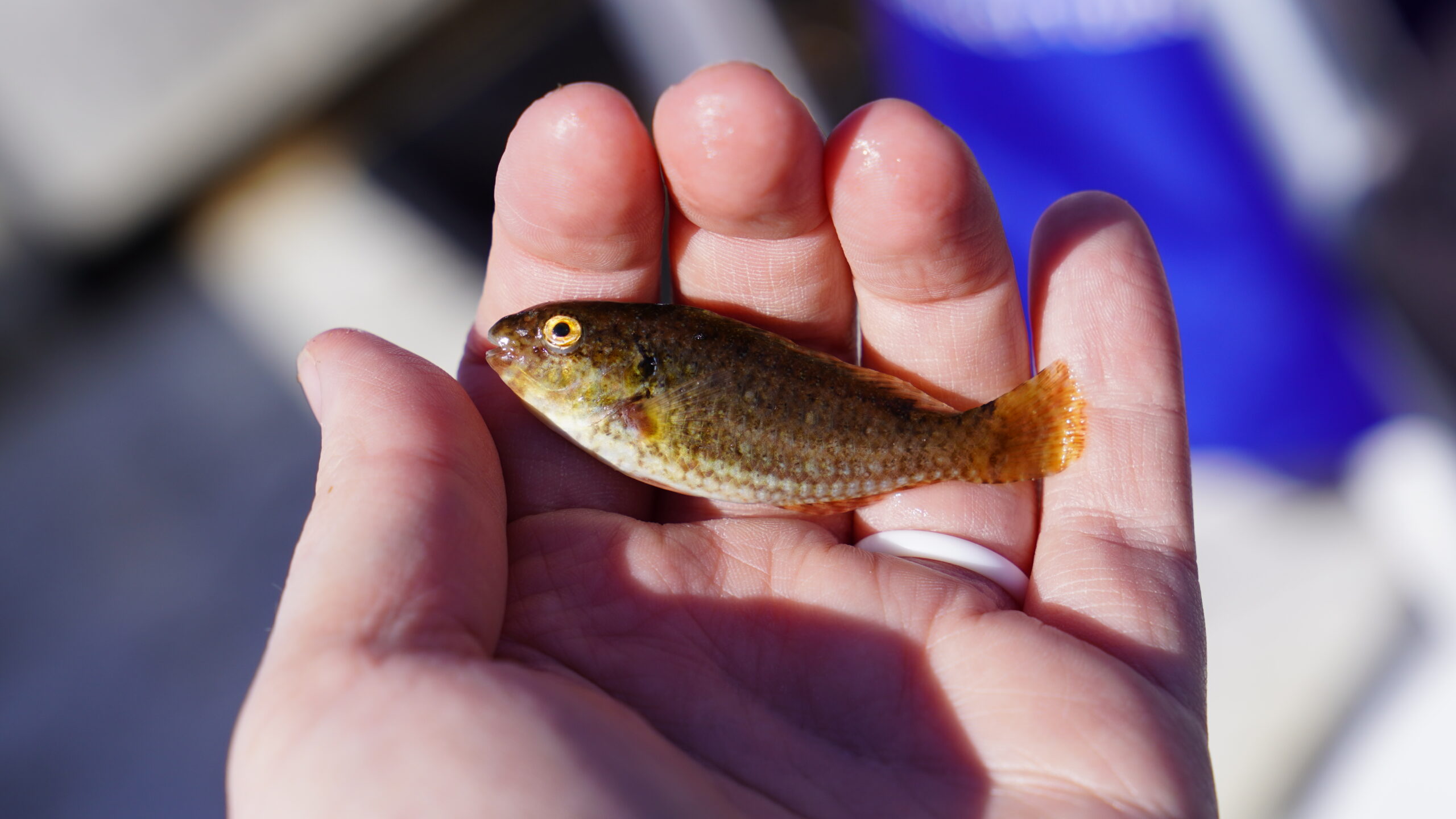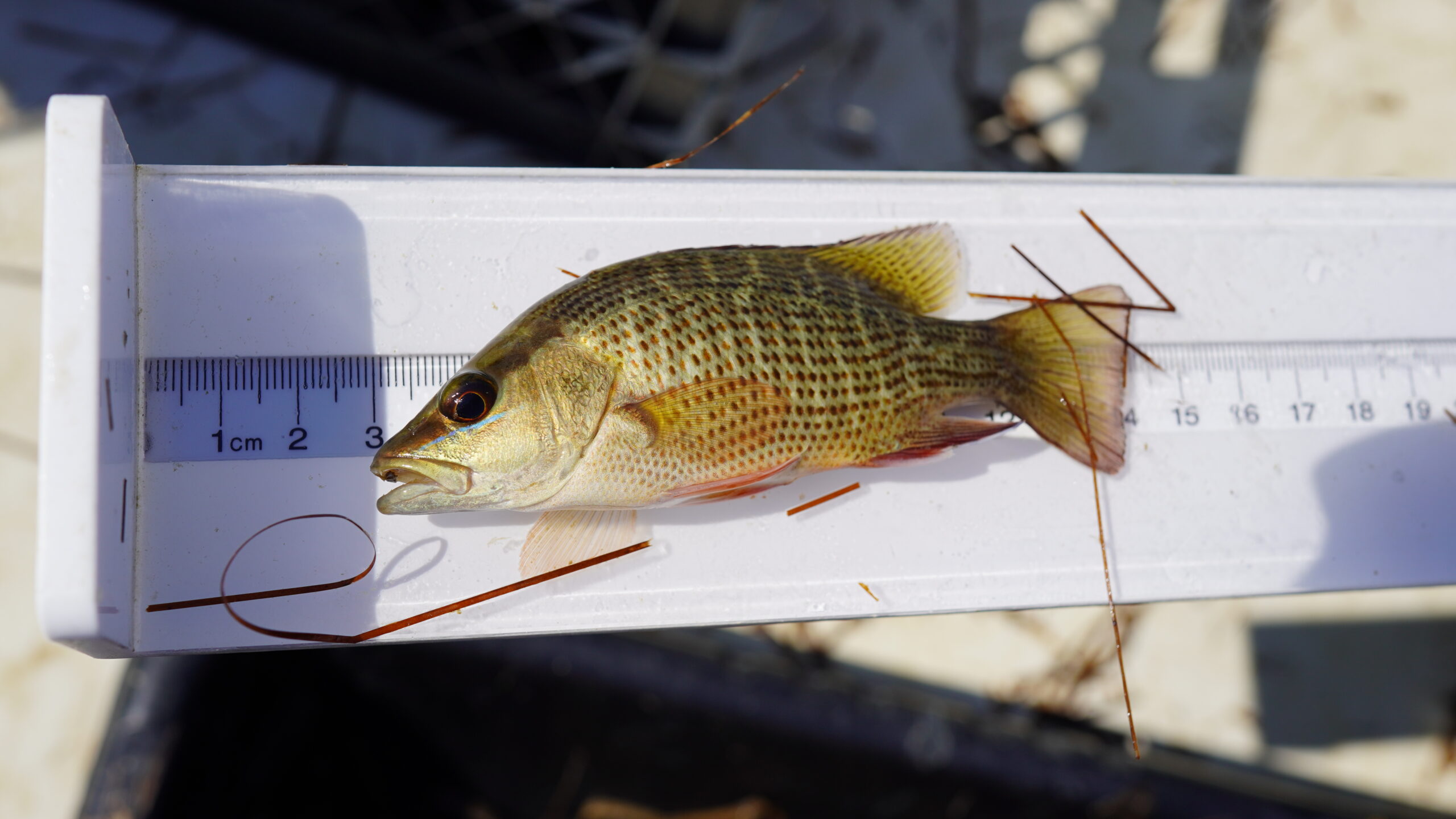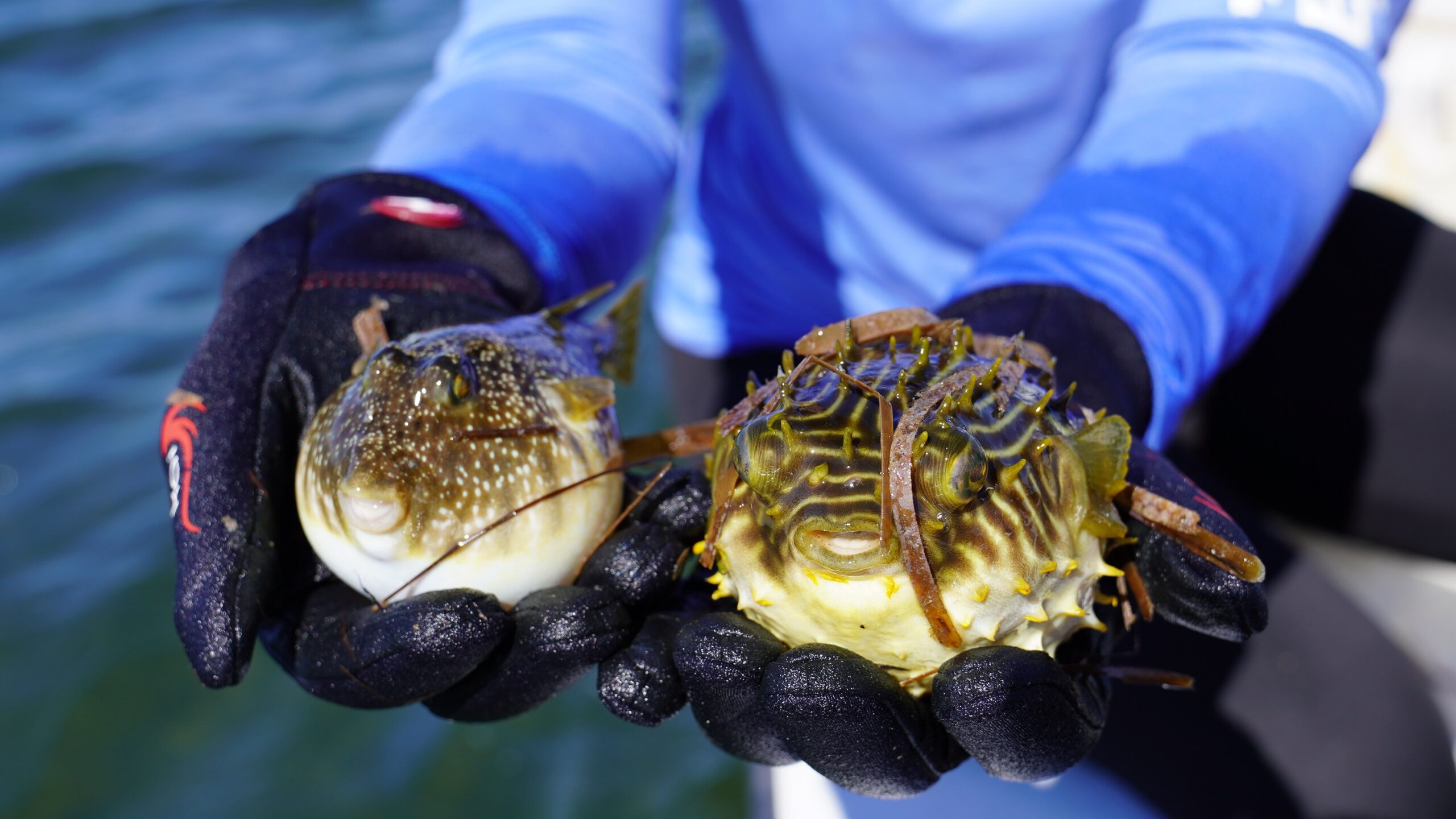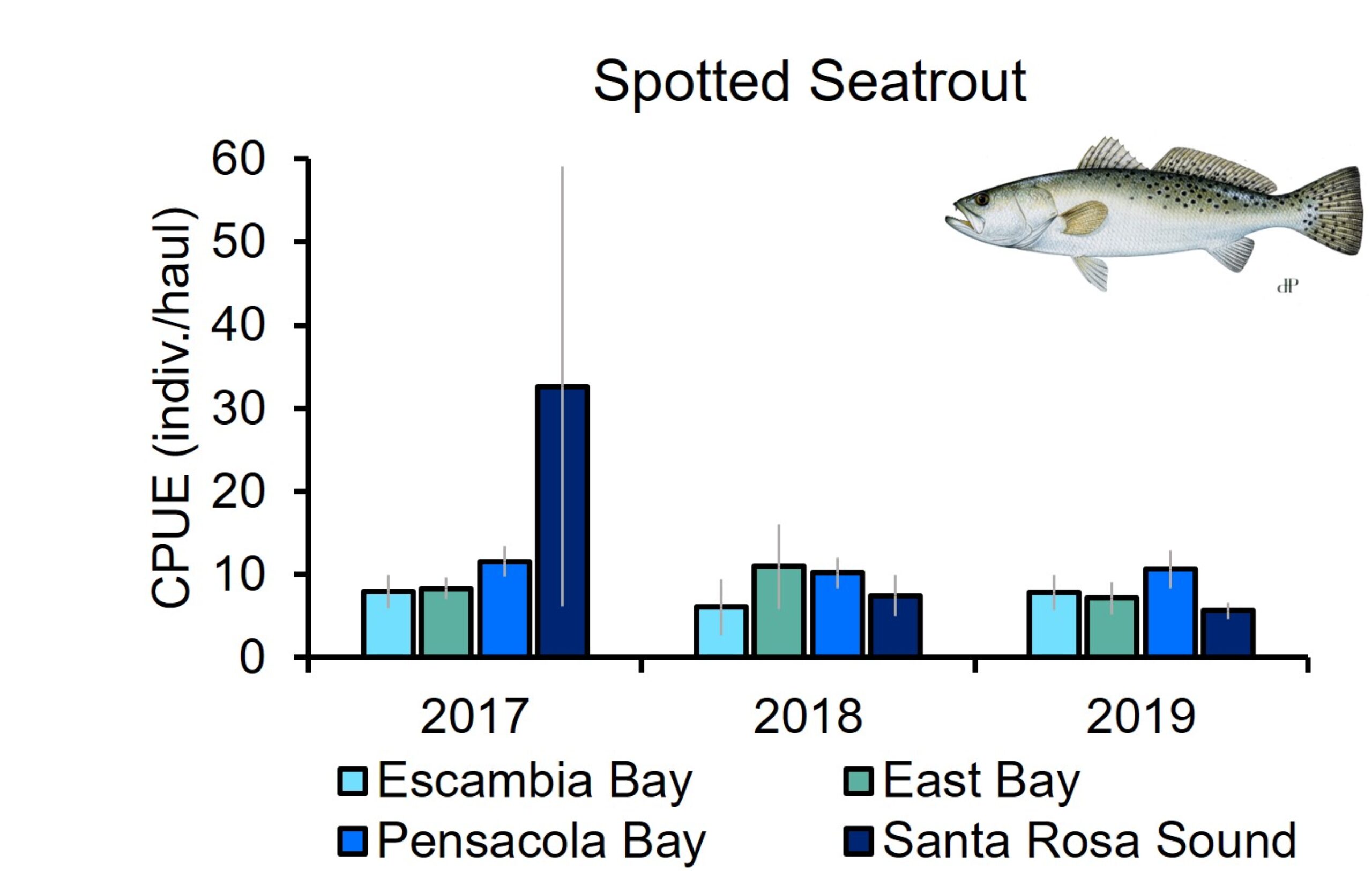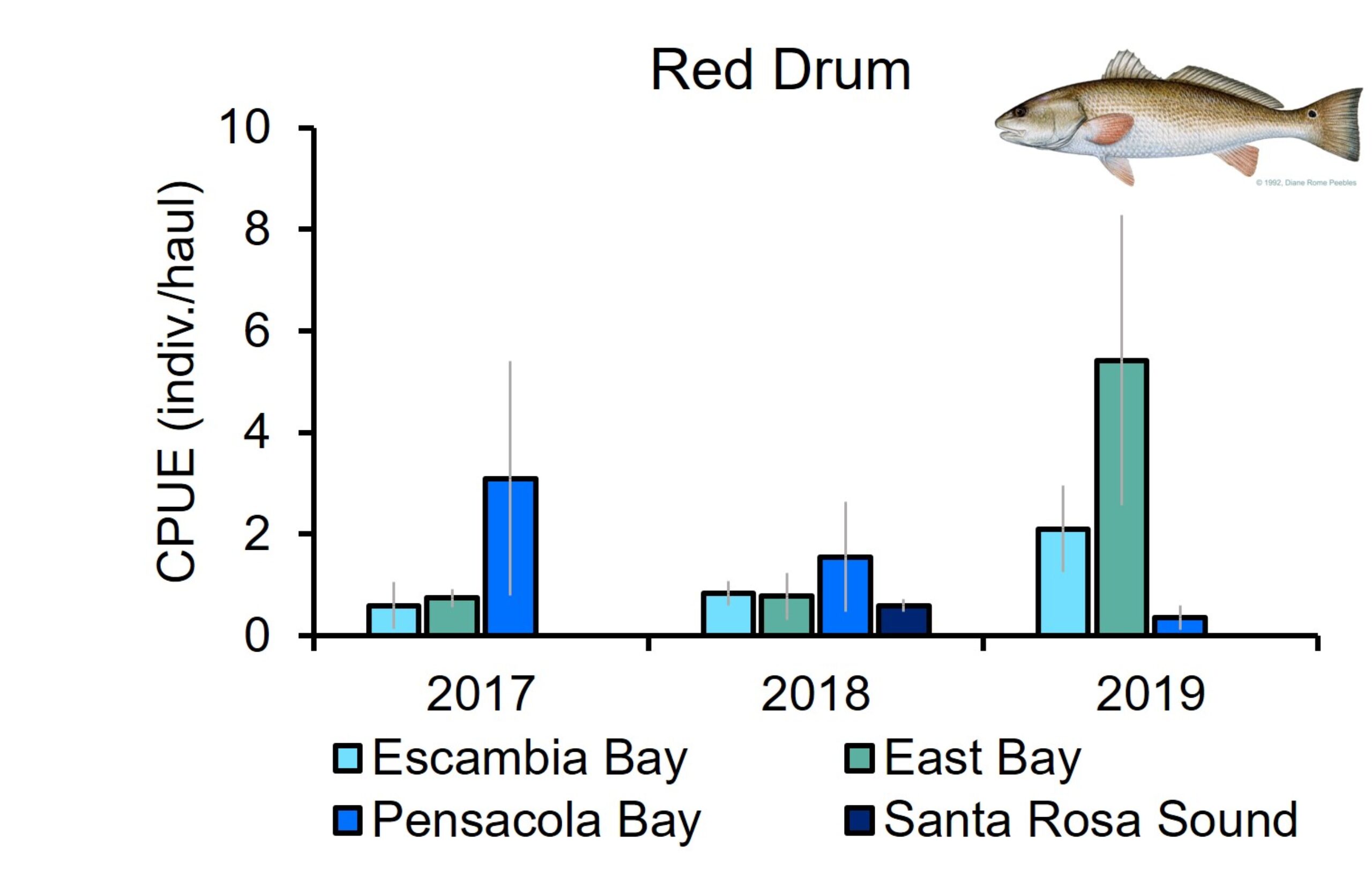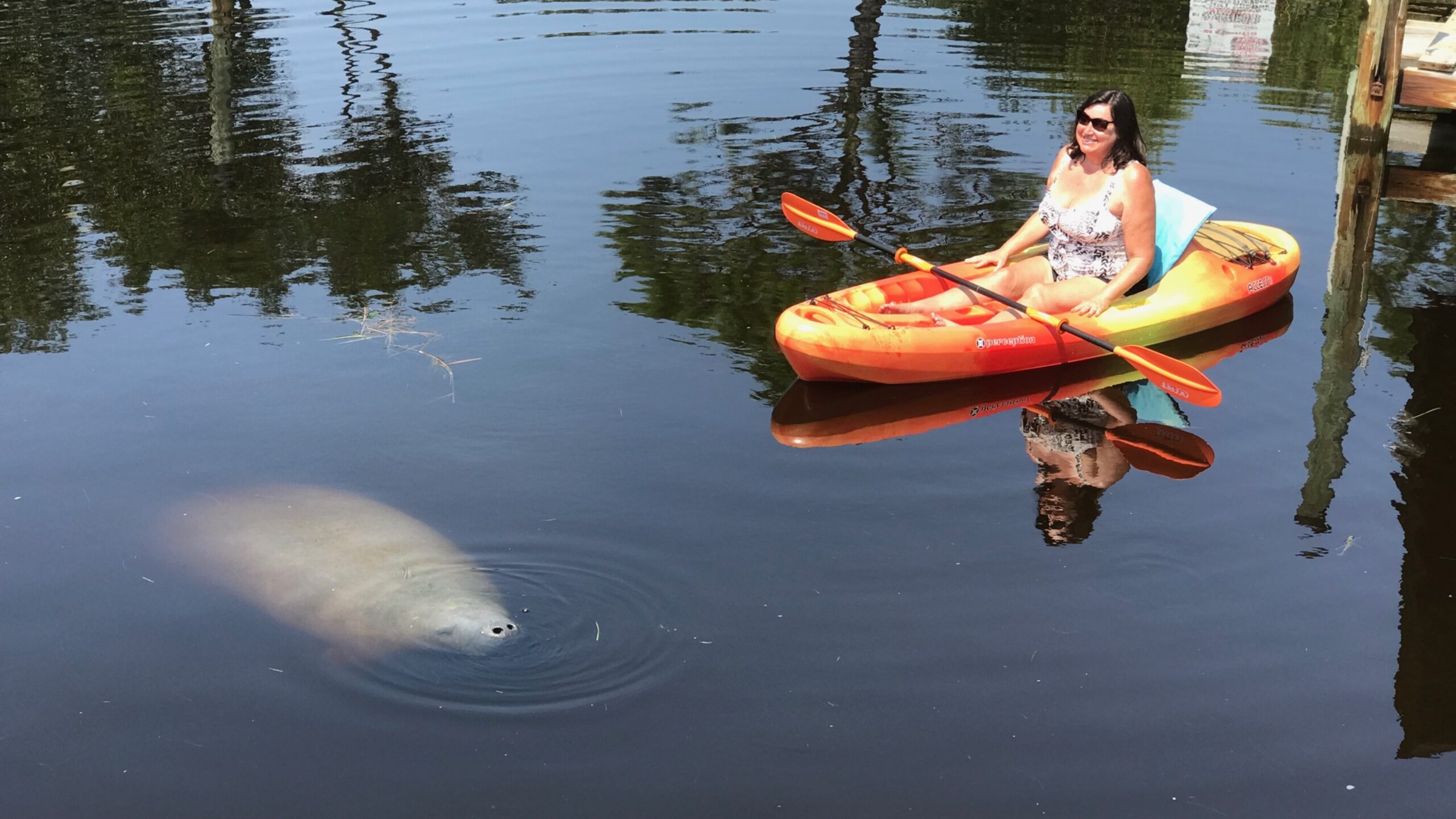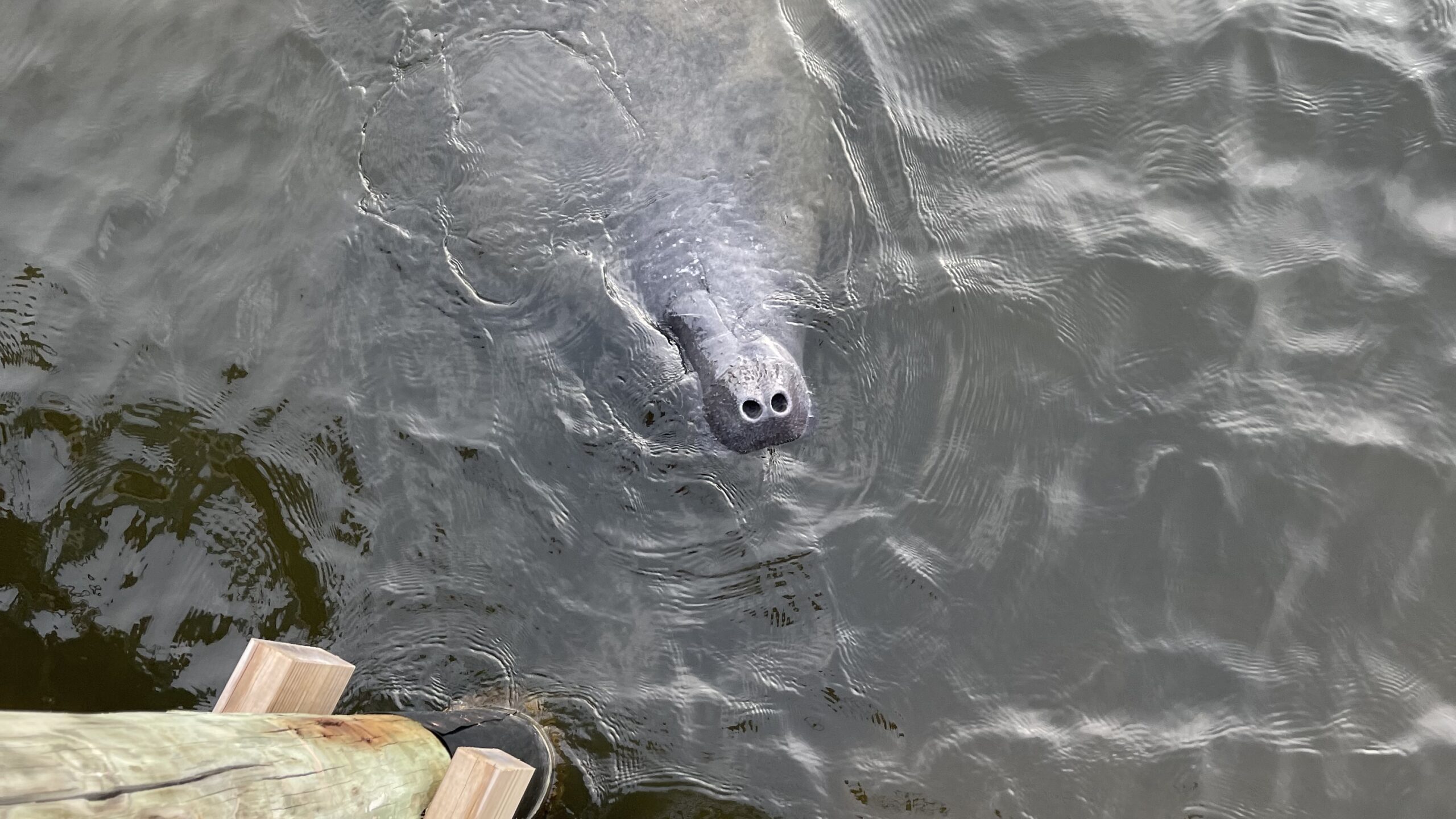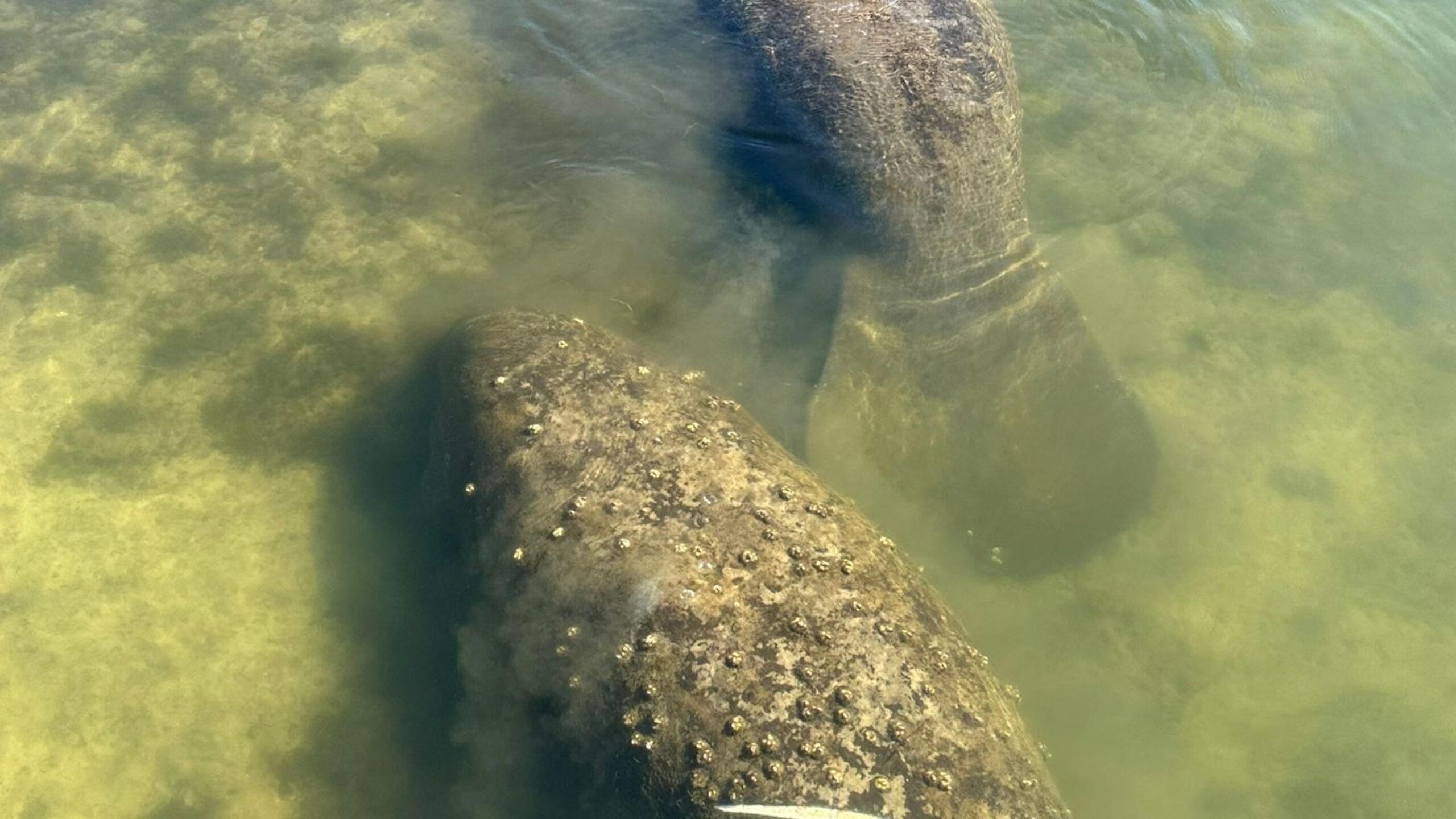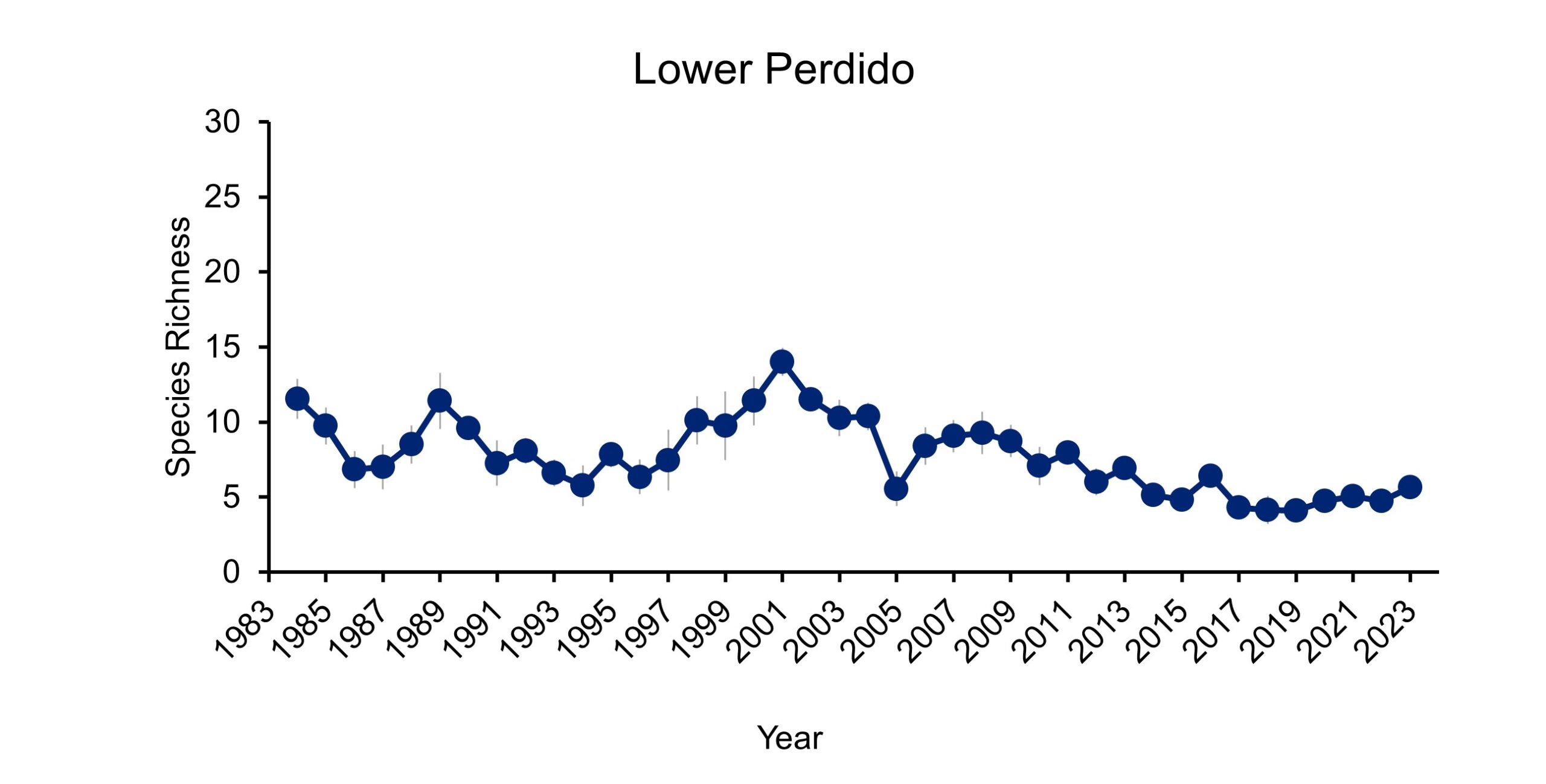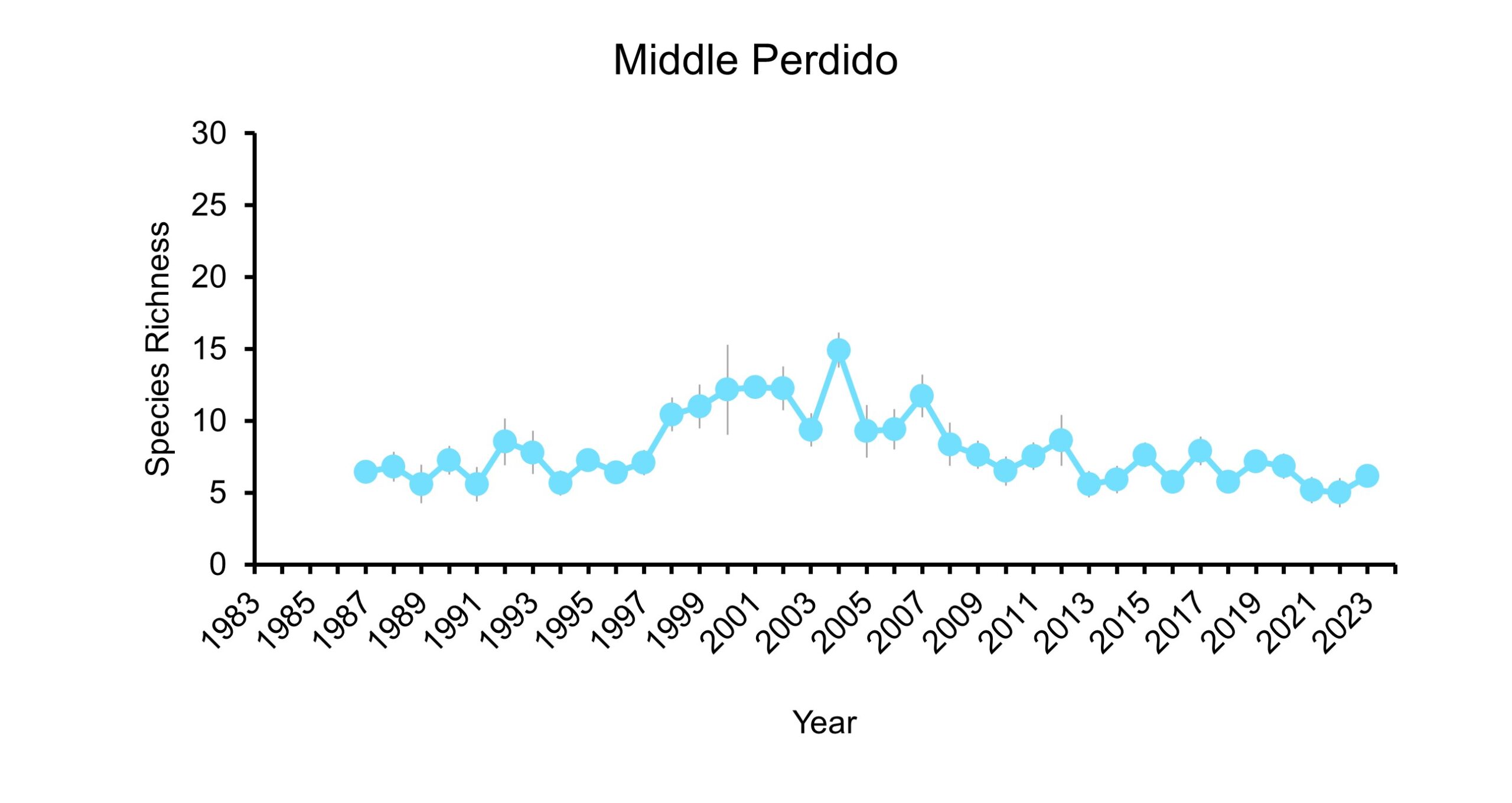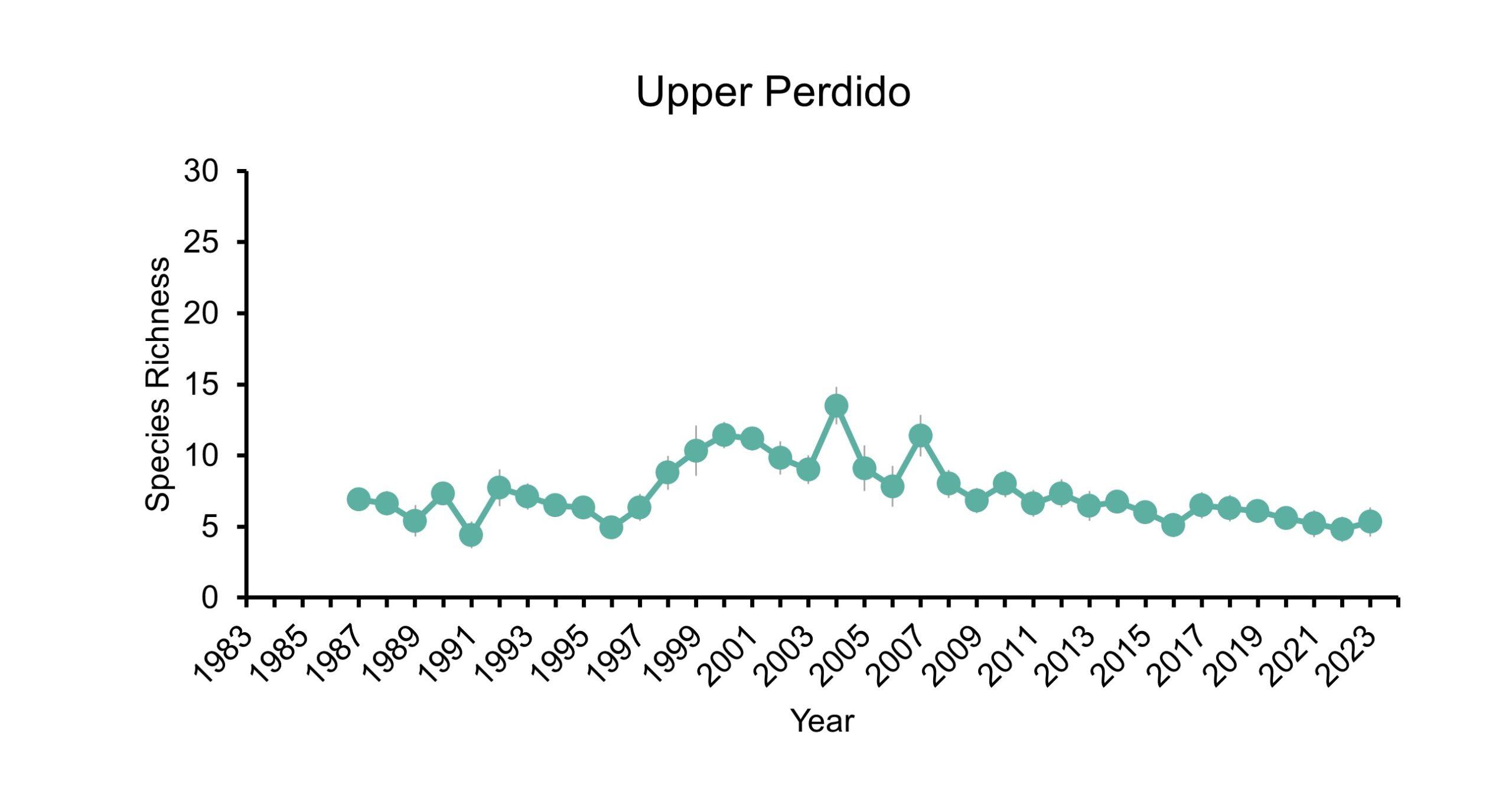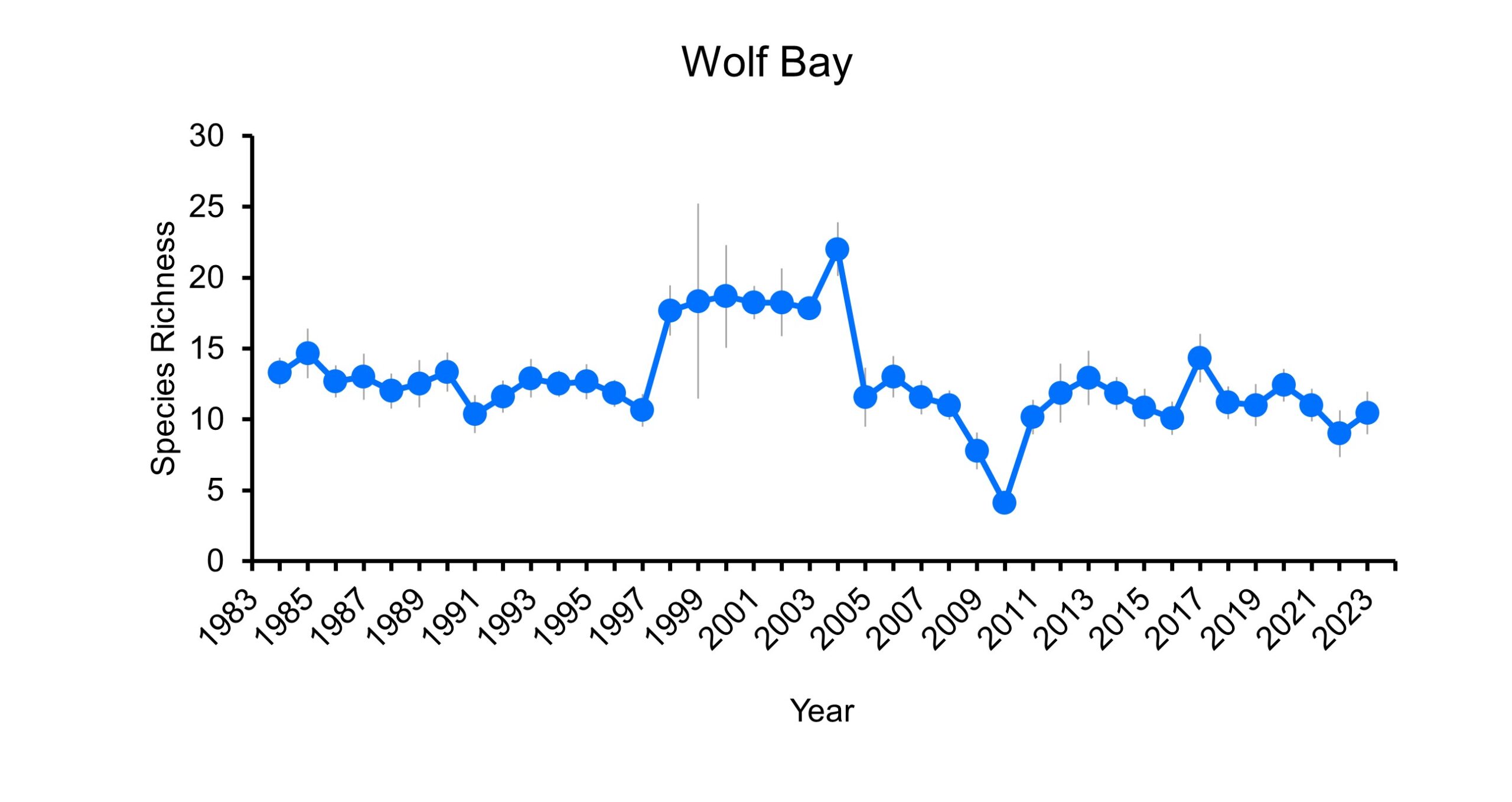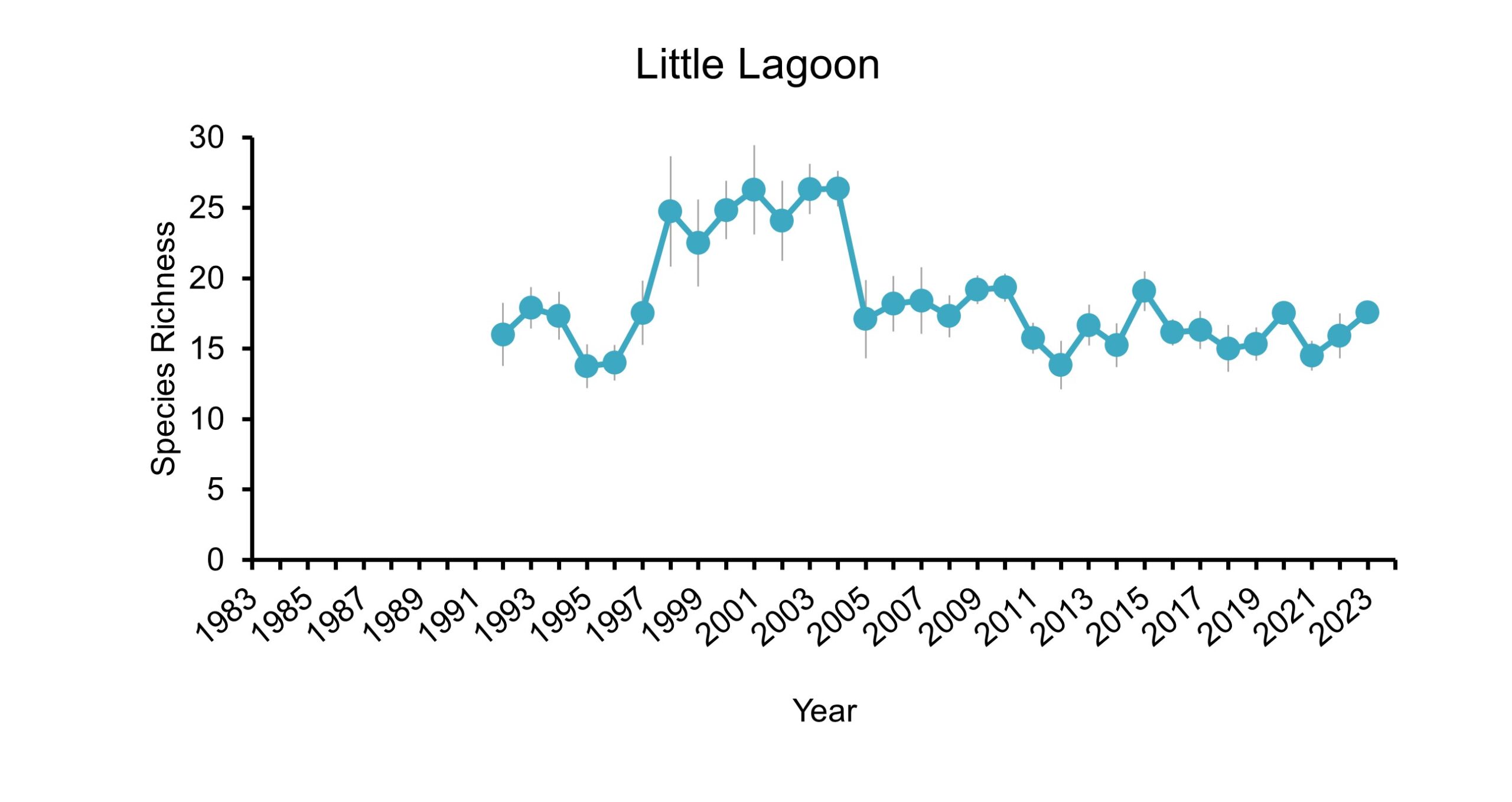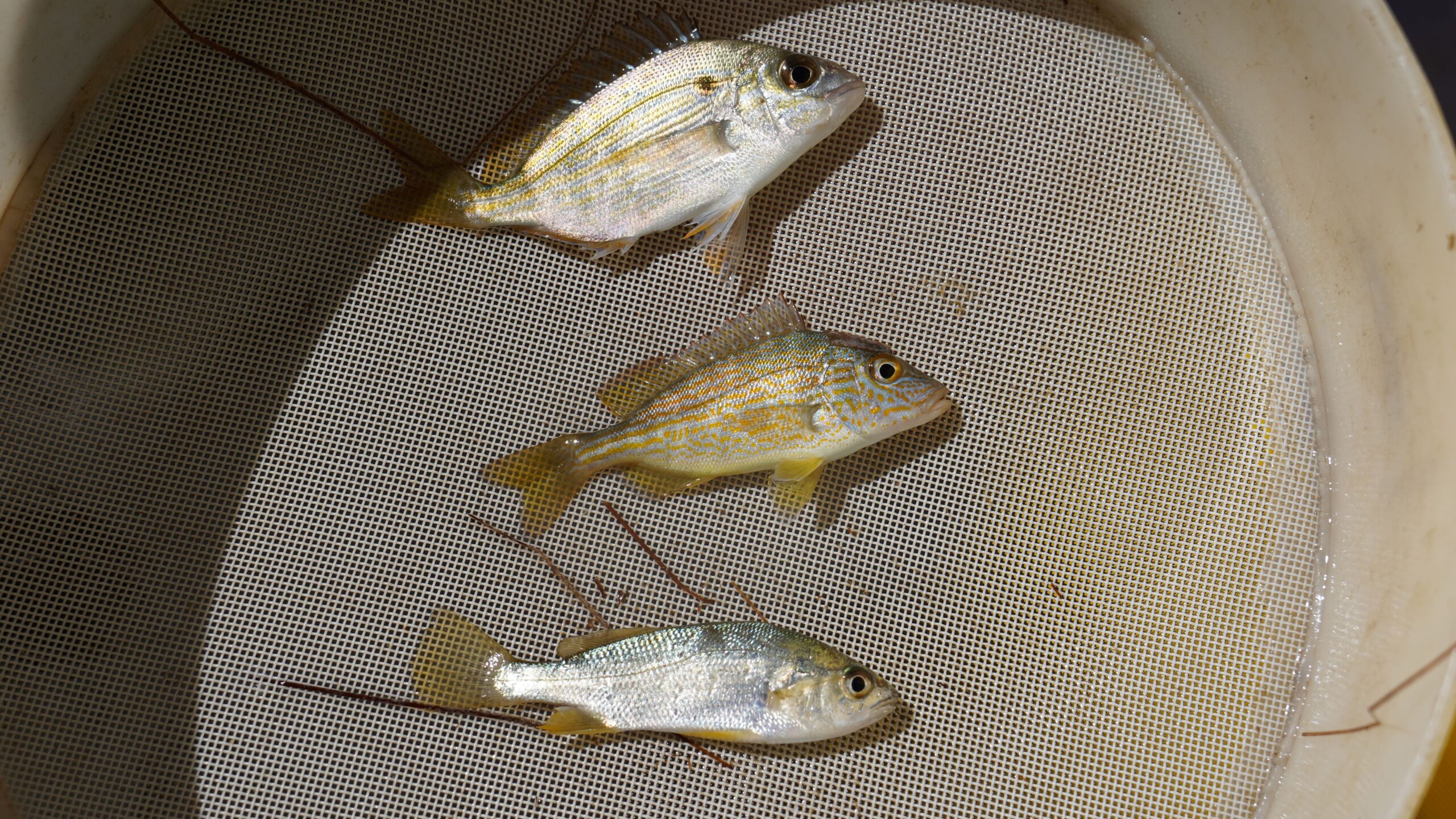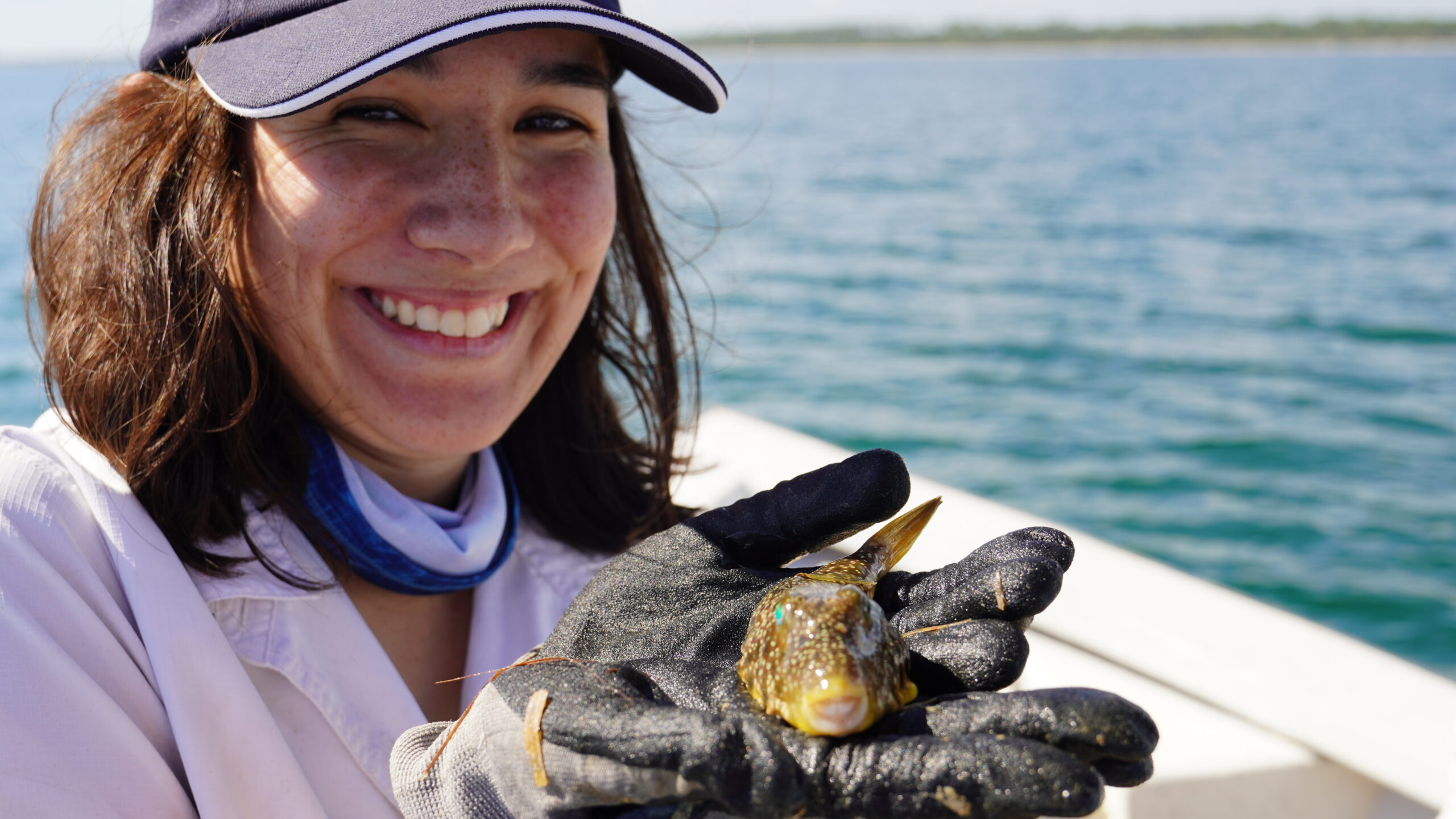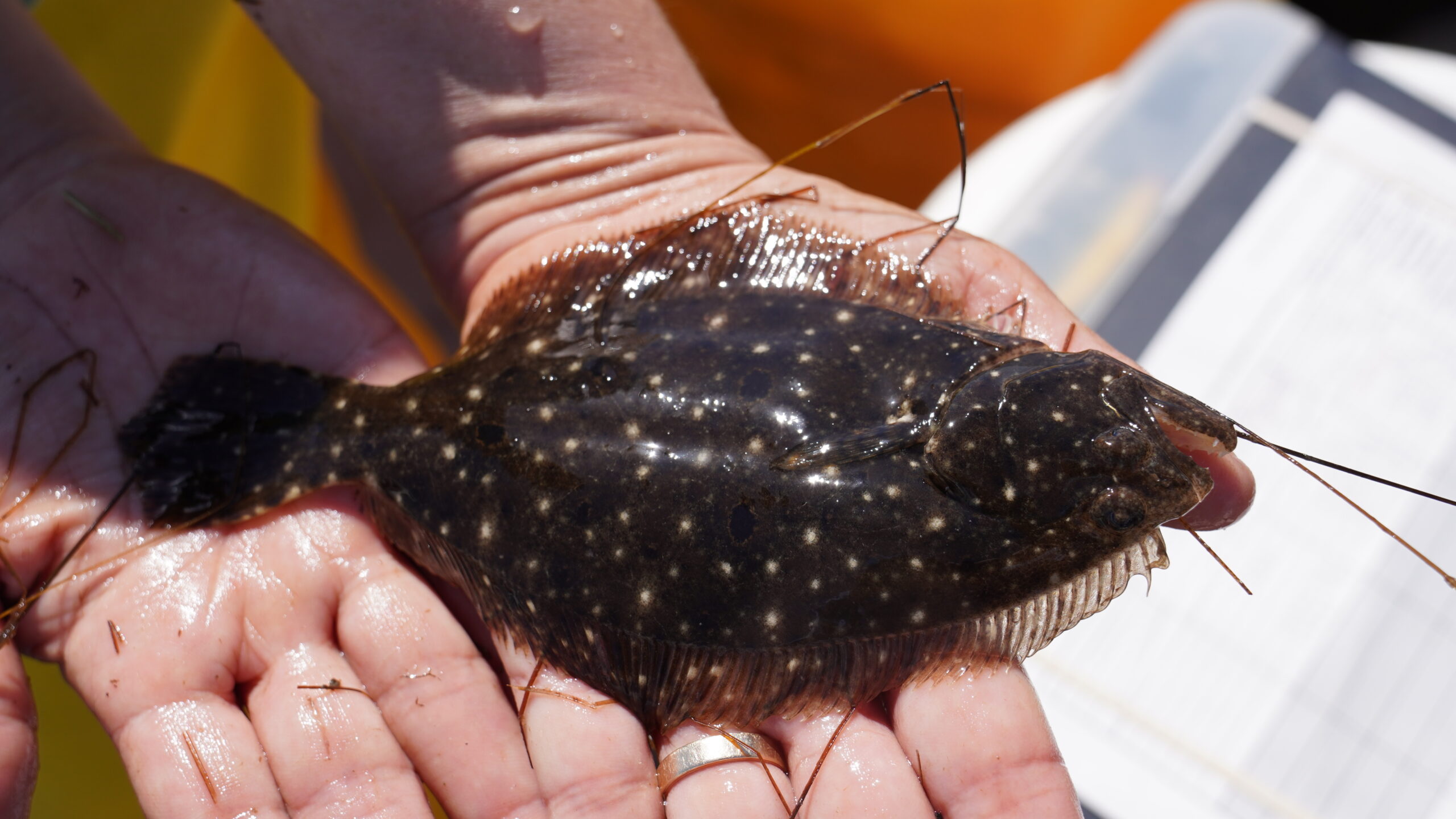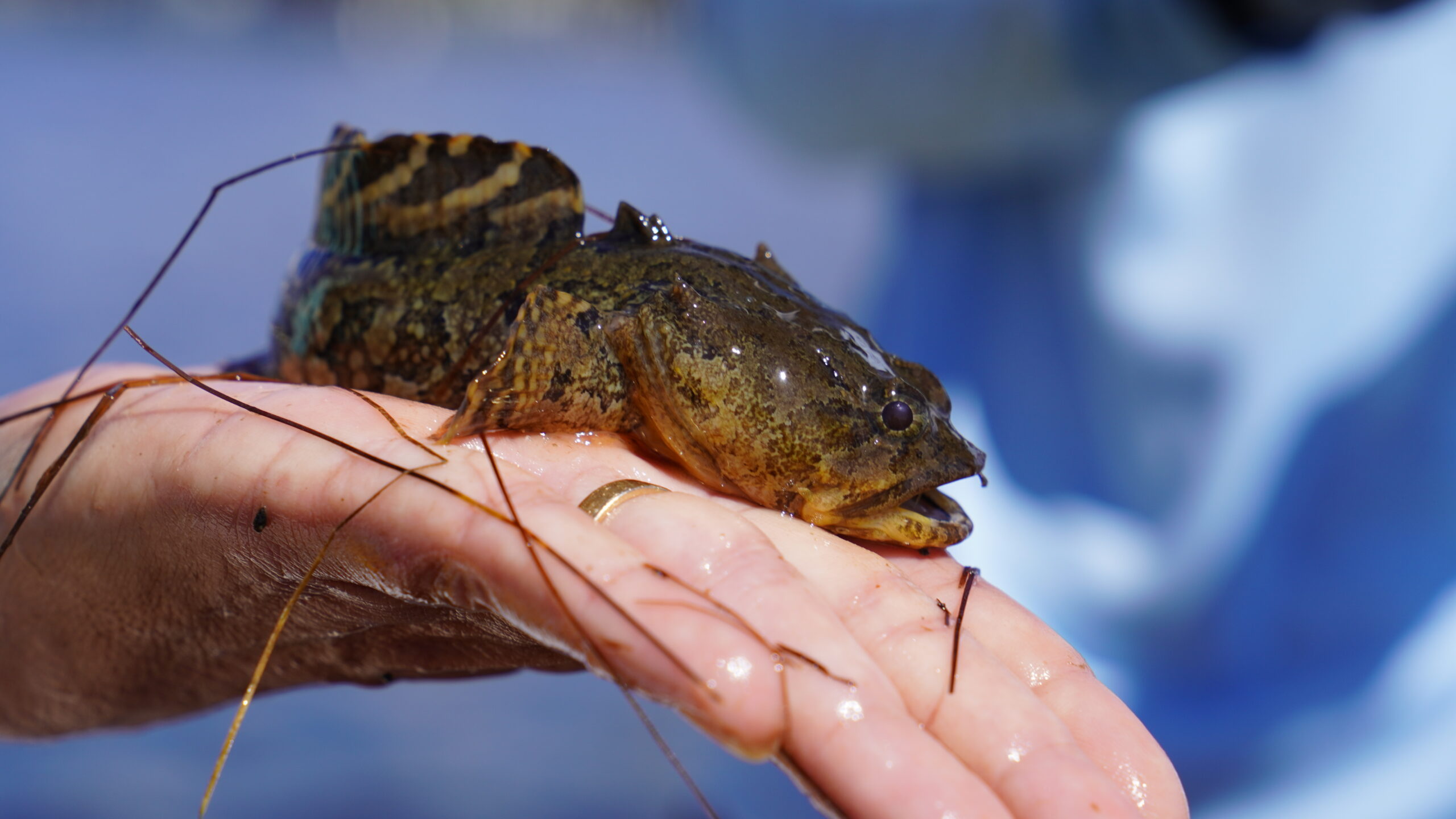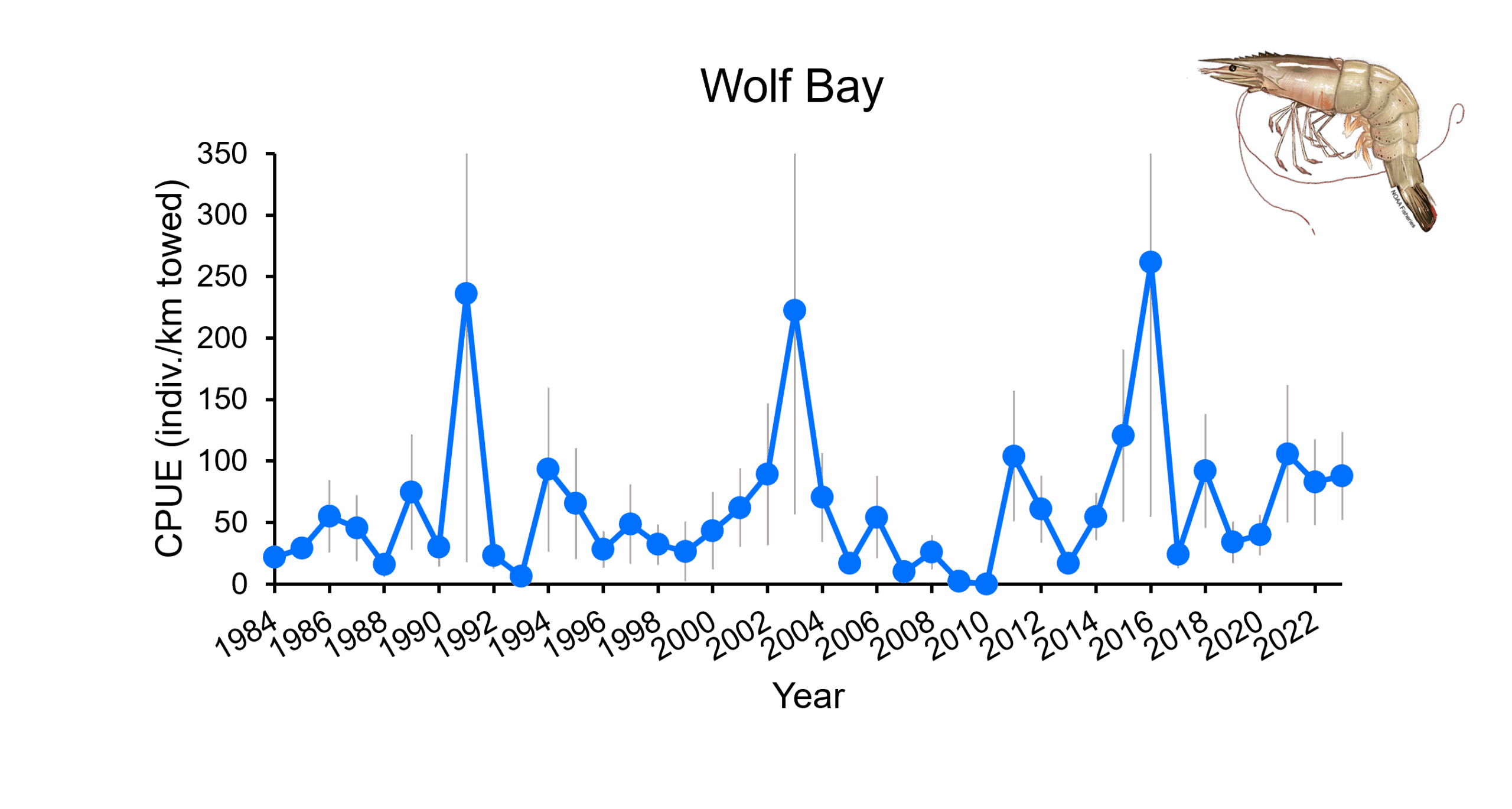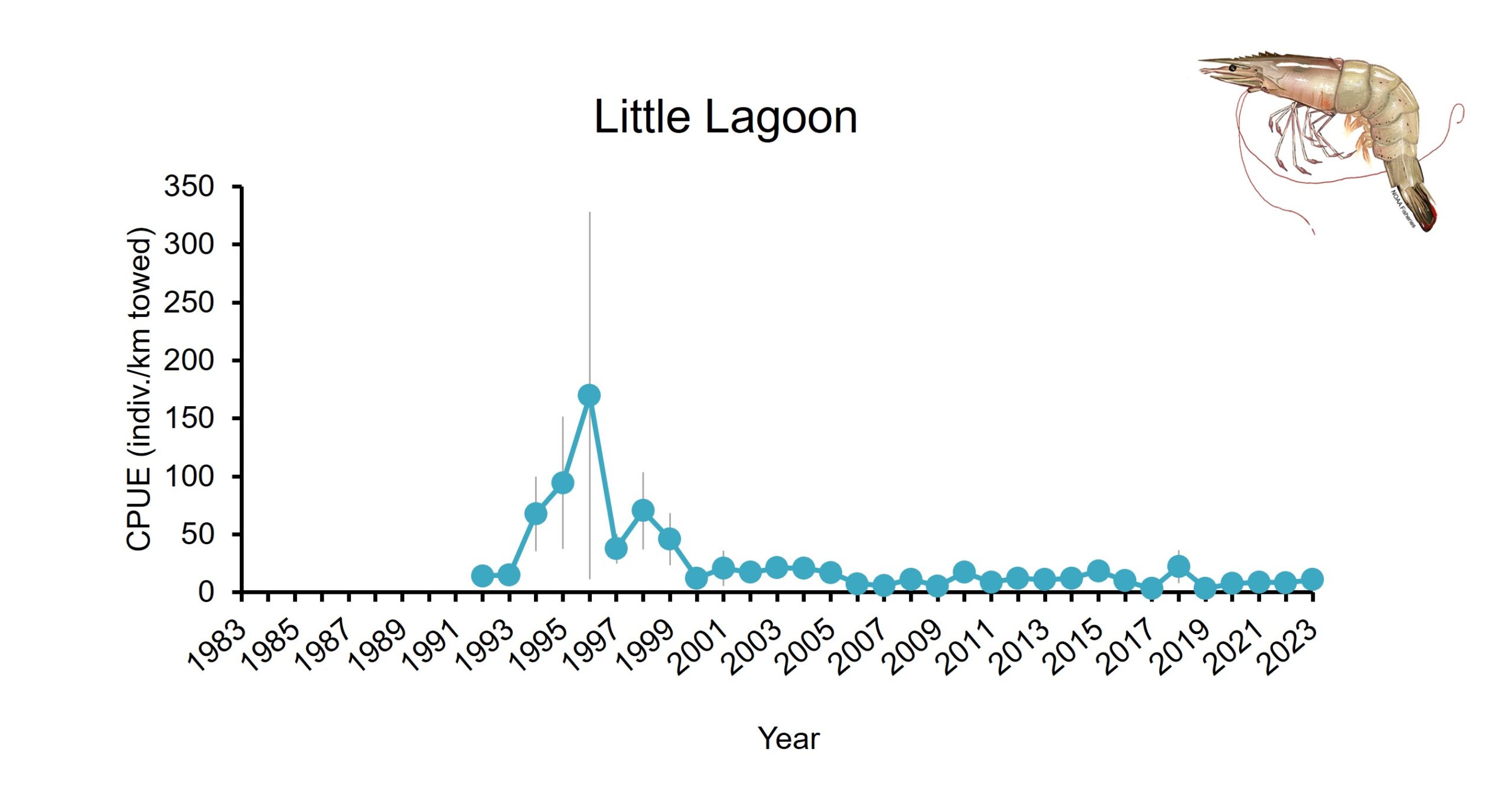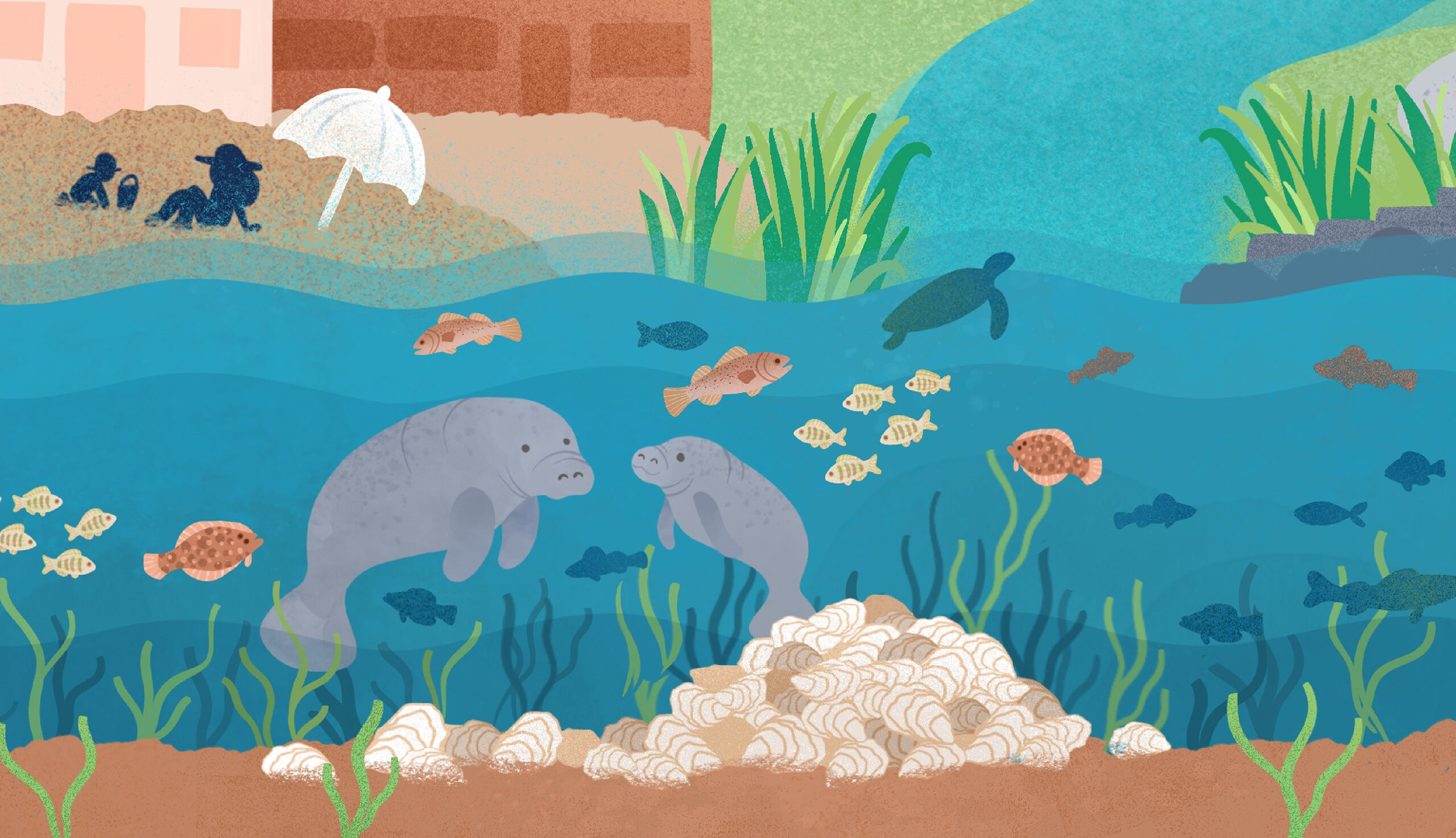

Wildlife in our Watersheds

Manatees:
Marine mammals, like manatees, migrating to the northern Gulf Coast are dependent on underwater plants, including seagrasses, that are found in shallow coastal waters.
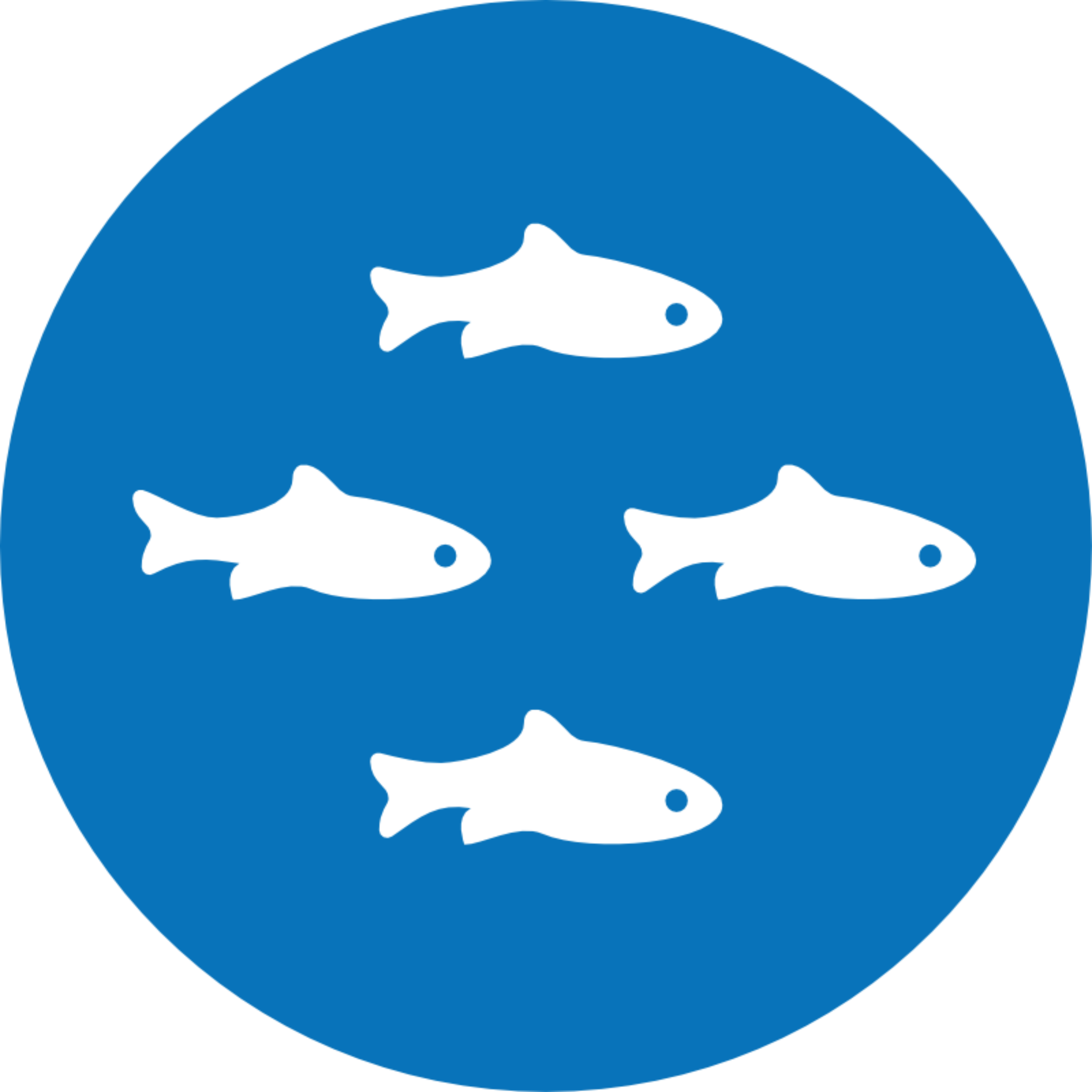
Fisheries:
Many different species of fish, crabs, and shrimp call our waters home. They use critical habitats such as seagrass beds, marshes, and oyster reefs as spawning, foraging, and nursery grounds.
Pensacola Bay Watershed
Manatees
The West Indian Manatee is a federally protected species with an estimated population of more than 6,500 individuals in the southeastern U.S. (USFWS). Manatees are commonly found in coastal and riverine areas of peninsular Florida and they migrate to the northern Gulf Coast during spring and summer, with peak sightings occurring June through August. They feed on seagrass and other aquatic plants in shallow marine and freshwater habitats.
- Manatees use our bays as a migratory corridor
- Most sightings occurred close to the coast, but manatees have been seen as far north as Blackwater River, FL
- Sightings increased after the start of Panhandle Manatee Program outreach efforts
- Increased sightings are likely a combination of increased awareness and more manatees in the area
- Your sightings help support manatee conservation!
How can you help manatees?
- Boat slow where seagrasses grow
Seagrass beds are an important manatee food source. Boat with caution to avoid manatees and seagrass - Report sightings at www.panhandlemanatee.org
Researchers depend on data from the public to track manatee habits - Volunteer with Panhandle Manatee!
Help protect manatees by educating residents and visitors - Do not feed or provide water to manatees
Doing so can change their natural behavior, migration patterns, and increase the risk of injury - Give manatees space
The best rule of thumb is to stay at least 100 feet away. Do not attempt to pet or swim with manatees - Properly discard used nets, fishing line, and trash
Entanglement or ingestion of marine debris can be fatal to manatees
Pensacola Bay manatee sightings, 2007-2024. Data from Dauphin Island’s Manatee Sighting Network.
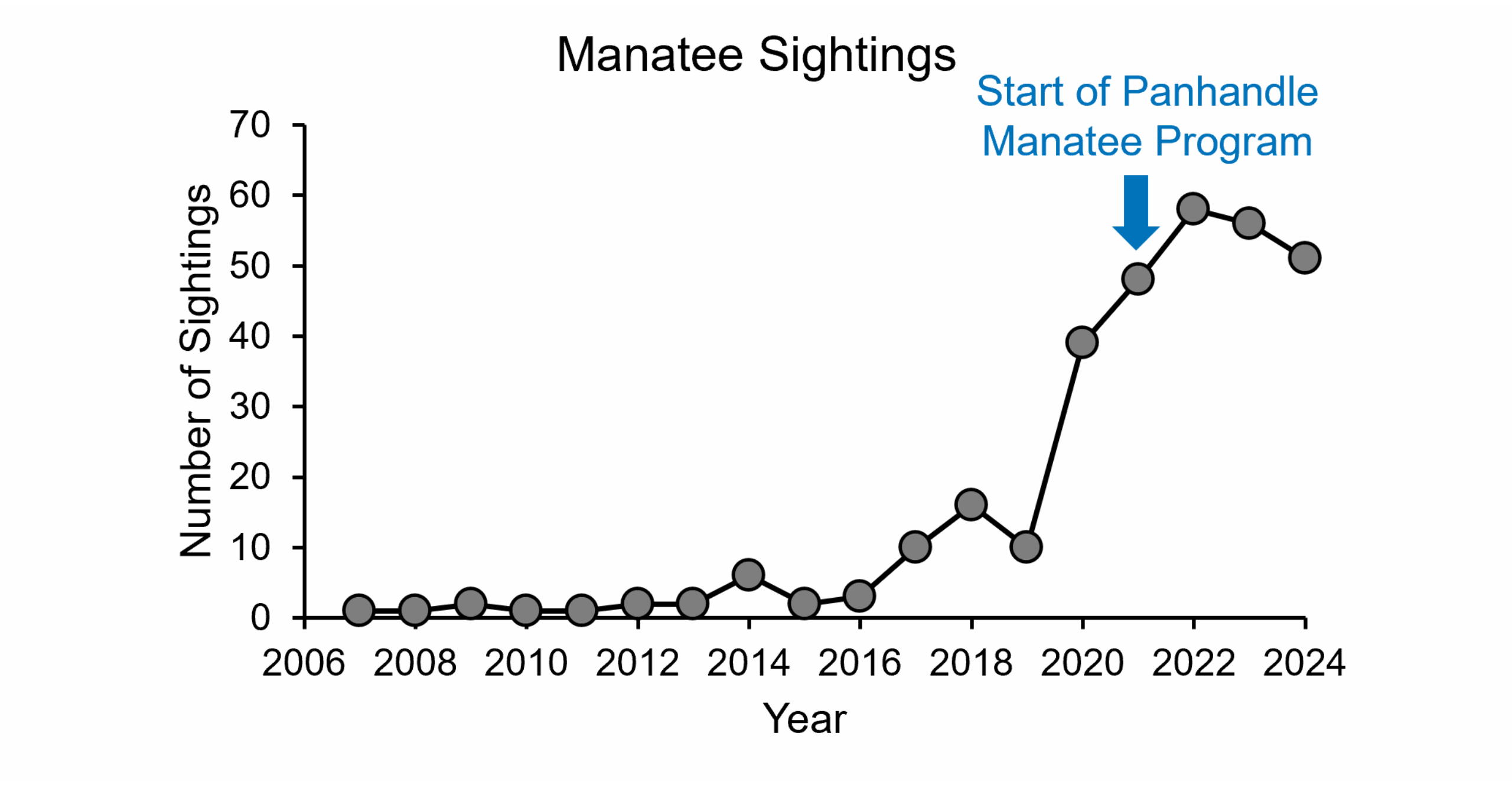
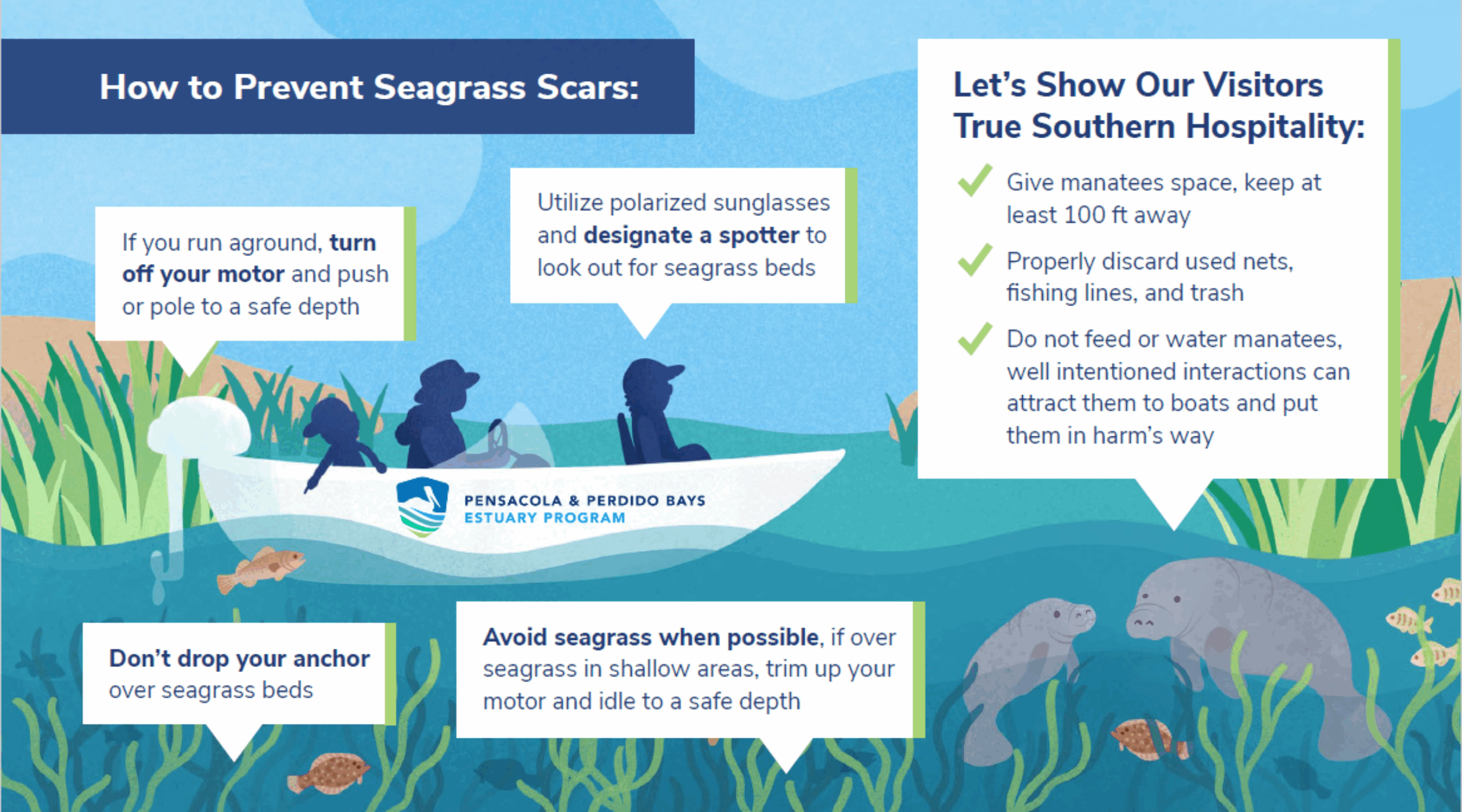
Fisheries
Many different species of fish, crabs, and shrimp call our waters home. They use critical habitats such as seagrass beds and oyster reefs as spawning, foraging, and nursery grounds. Healthy fisheries are needed to support recreational and commercial fishing as well as thriving ecosystems. Changes within fisheries can reflect broader environmental shifts like pollution, habitat degradation, and harvesting pressures.
The Florida Fish and Wildlife Conservation Commission’s (FWC) Fish and Wildlife Research Institute (FWRI) oversees the Fisheries-Independent Monitoring program (FIM), which collects data on hundreds of fish and invertebrate species that inhabit Florida’s coastal habitats.
- FWRI initiated FIM in 1989 in southwest Florida, but monthly monitoring is limited to Apalachicola Bay in Northwest Florida.
- Santa Rosa Sound: FWC conducts FIM seasonally
The Dauphin Island Sea Lab (DISL) established a trawl survey program in 2006 to evaluate juvenile fish communities in seagrass beds throughout lower Pensacola Bay and Santa Rosa Sound. Due to a lack of consistent funding, gaps in monitoring have occurred. From 2022 to the present, PPBEP has provided funding for the annual trawl survey to ensure the continuation of consistent monitoring. Learn more
Fish abundances can change annually due to environmental variables such as drought, rainfall, intense storms, water temperatures, and habitat alterations. Long-term factors that can chronically impact fish populations include changes in weather patterns over decades and overfishing.
- There is a lack funding support for consistent fisheries monitoring
- Due to data gaps, it is difficult to determine how these fish populations are changing over time
- The most commonly caught species in the highest abundances are Atlantic Croaker, Spot, Pinfish, Gulf Menhaden, and Bay Anchovy
HELp support healthy fisheries!
- Be Seagrass Aware – trim up your motor when boating over shallow seagrass beds to prevent propeller scarring that damages important fish habitat
- Support our efforts to restore critical oyster habitat in Pensacola Bay
- Install a living shoreline on your property to boost fish habitat
- Practice smart fertilizer use to reduce algal growth and fish die offs
- Choose sustainable, local seafood
- Know your limits!
Species of Interest
Take a deeper dive into abundance trends for three key species: Specked Trout and Gray Snapper. These species were selected due to their significant commercial and recreational value, their importance for state and federal fisheries management, and they serve as good indicators of the health of our estuaries.
Speckled Trout (Spotted Seatrout):
- Speckled Trout are a popular game fish
- They inhabit coastal waters, specifically sandy bottoms or seagrass beds when they are juveniles and spend their whole life in the estuary
- Their main food sources include baitfish, mullet, shrimp, and crabs
Gray Snapper (Mangrove Snapper):
- Gray Snapper is a popular sportfish that is also fished commercially
- They occupy coastal waters near structure such as reefs, mangroves, and seagrass beds, spending their early years in estuaries and moving offshore as adults
- Throughout the 1970s, researchers reported that Gray Snapper were not found as far north as our waters
- In the 2000s, Gray Snapper became abundant in our region. Many Gulf estuaries have seen an increase in tropical fish species over the last few decades
- Researchers found that most adults on Alabama’s offshore reefs originated from seagrass habitat in the Florida Panhandle
- The highest abundances of Gray Snapper were found in lower Pensacola Bay and Santa Rosa Sound
Pensacola Bay Watershed Fisheries Monitoring Segments
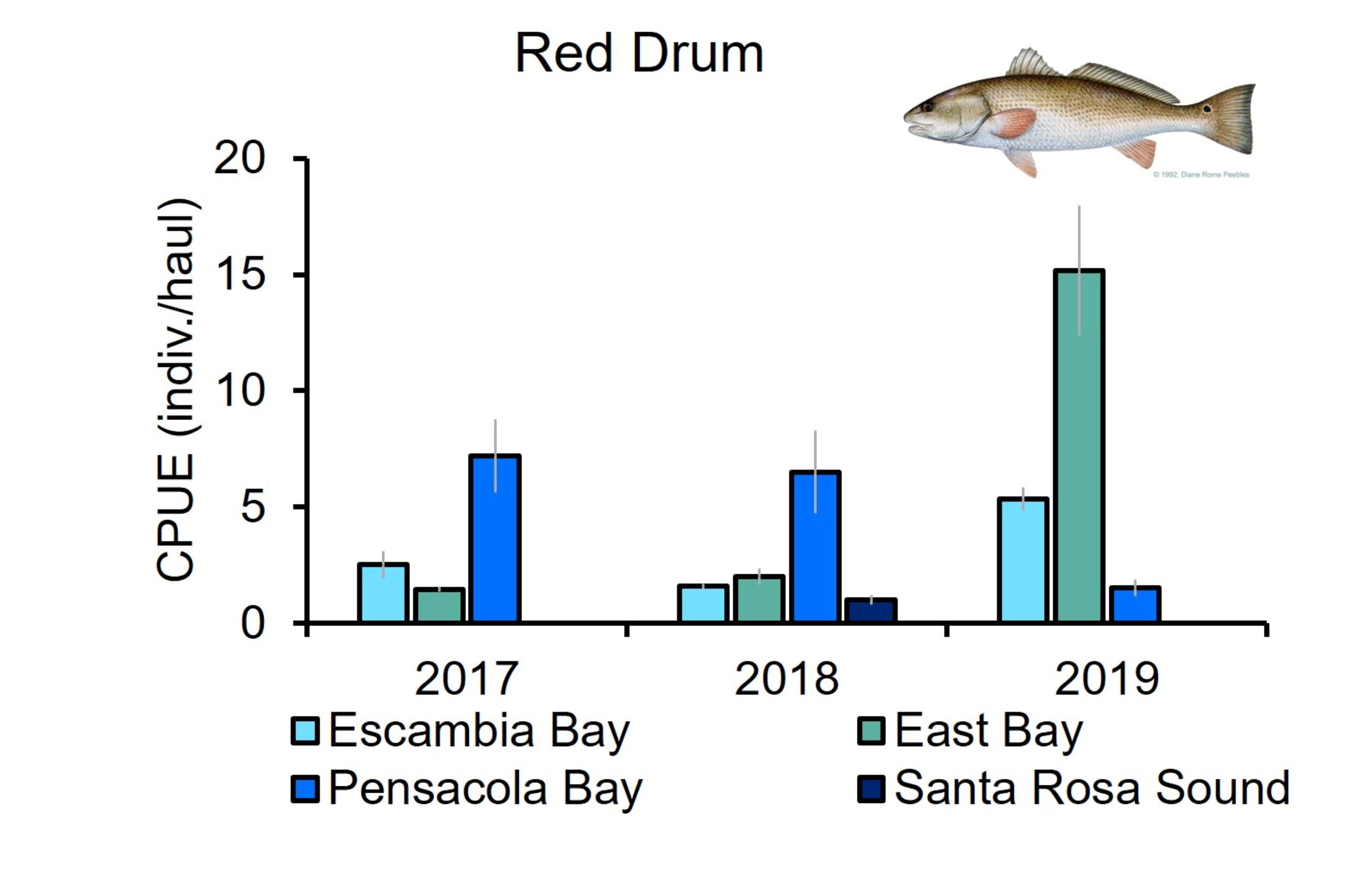
Perdido Bay Watershed
Manatees
The West Indian Manatee is a federally protected species with an estimated population of more than 6,500 individuals in the southeastern U.S. (USFWS). Manatees are commonly found in coastal and riverine areas of peninsular Florida and they migrate to the northern Gulf Coast during spring and summer, with peak sightings occurring June through August. They feed on seagrass and other aquatic plants in shallow marine and freshwater habitats.
- Manatees use our coastal areas as migratory corridors
- Most sightings occurred in lower Perdido Bay and Intracoastal Waterway (ICW), but manatees have been seen as far north as Blackwater River, AL
- Increased sightings are likely a combination of increased awareness and more manatees in the area
- Your sightings help support manatee conservation!
How can you help manatees?
- Boat slow where seagrasses grow
Seagrass beds are an important manatee food source. Boat with caution to avoid manatees and seagrass - Report sightings at www.panhandlemanatee.org
Researchers depend on data from the public to track manatee habits - Volunteer with Panhandle Manatee!
Help protect manatees by educating residents and visitors - Do not feed or provide water to manatees
Doing so can change their natural behavior, migration patterns, and increase the risk of injury - Give manatees space
The best rule of thumb is to stay at least 100 feet away. Do not attempt to pet or swim with manatees - Properly discard used nets, fishing line, and trash
Entanglement or ingestion of marine debris can be fatal to manatees
Perdido Bay manatee sightings, 2007-2024. Data from Dauphin Island’s Manatee Sighting Network
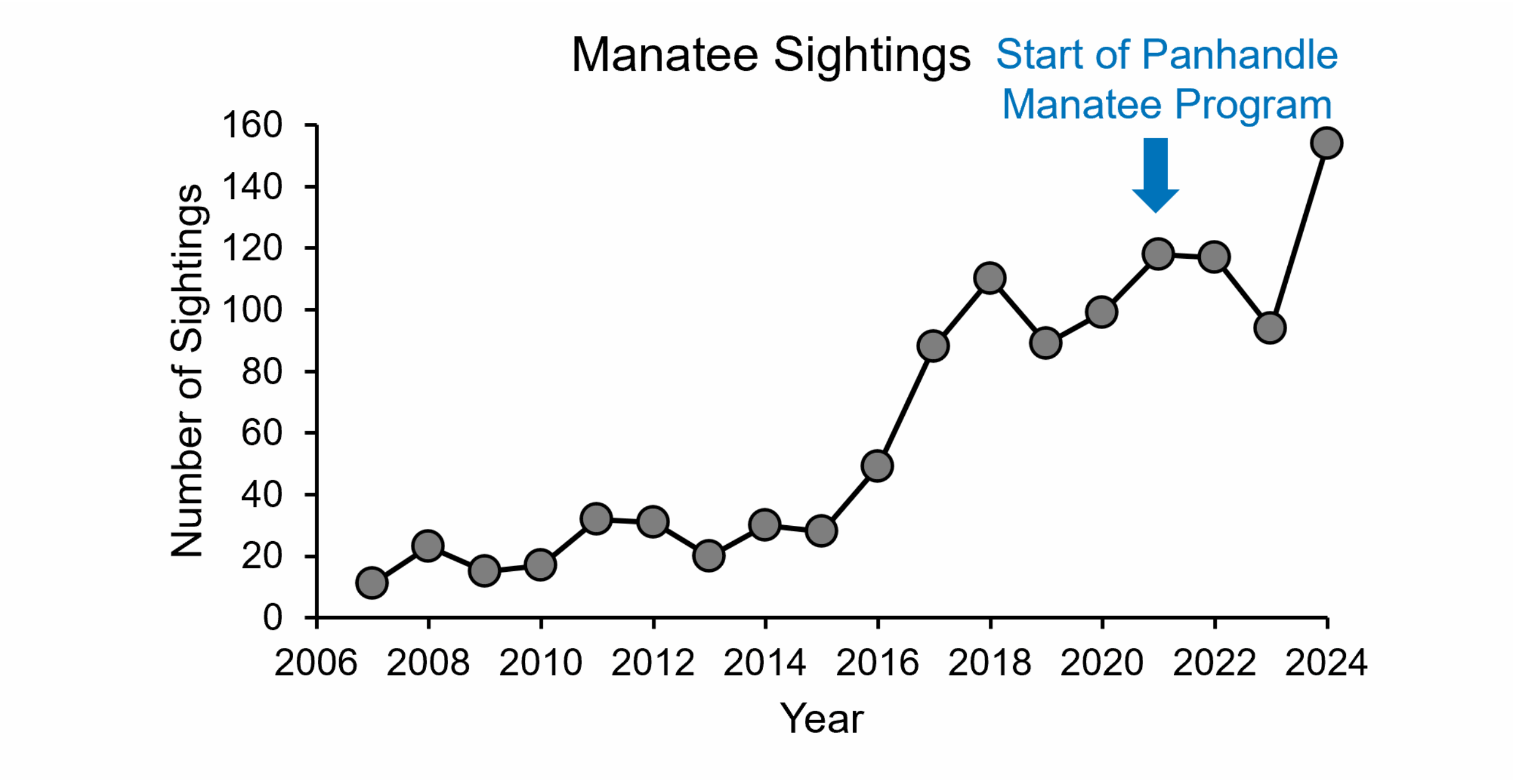

Fisheries
Many different species of fish, crabs, and shrimp call our waters home. They use critical habitats such as seagrass beds and oyster reefs as spawning, foraging, and nursery grounds. Healthy fisheries are needed to support recreational and commercial fishing as well as thriving ecosystems. Changes within fisheries can reflect broader environmental shifts like pollution, habitat degradation, and harvesting pressures.
The Alabama Department of Conservation and Natural Resources’ Marine Resources Division (MRD) established the Fisheries Assessment and Monitoring Program (FAMP) to provide data that helps determine the population status of several economically important species in Alabama’s coastal waters.
- Trawling surveys began in 1977 to collect data for managing shrimp harvest
- The Program expanded over time to collect community-level fisheries data
- Monthly trawls are completed at eight sites across the Perdido Bay System. Learn more
The Dauphin Island Sea Lab (DISL) established an additional trawl survey program in 2006 to evaluate juvenile fish communities in seagrass beds throughout the lower Perdido Islands and Big Lagoon. Due to a lack of consistent funding, gaps in monitoring have occurred . From 2022 to the present, PPBEP has provided funding for the annual trawl survey to ensure the continuation of consistent monitoring. Learn more
- Fish abundances can change annually due to environmental variables such as drought, rainfall, intense storms, water temperatures, and habitat alterations
- Long-term factors that can chronically impact fish populations include changes in weather patterns over decades and overfishing
- Species richness has remained stable over time for all bay segments
HELP SUPPORT HEALTHY FISHERIES!
- Be seagrass aware – trim up your motor when boating over shallow seagrass beds to prevent propeller scarring that damages important fish habitat
- Support our efforts to restore critical oyster habitat in Pensacola Bay
- Install a living shoreline on your property to boost fish habitat
- Practice smart fertilizer use to reduce algal growth and fish die offs
- Choose sustainable, local seafood
- Know your limits!
Species of Interest
Take a deeper dive into abundance trends for three key species: brown shrimp, speckled trout, and gray snapper. These species were selected due to their significant commercial and recreational value, their importance for state and federal fisheries management, and they serve as good indicators of the health of our estuaries.
Spotted Seatrout (Speckled Trout):
- Speckled Trout are a popular game fish
- They inhabit coastal waters, specifically sandy bottoms or seagrass beds when they are juveniles and spend their whole life in the estuary
- Their main food sources include baitfish, mullet, shrimp, and crabs
- They were found in the greatest abundances in Little Lagoon beginning in the early 2000s, likely due to the availability of seagrass habitat
Gray Snapper (Mangrove Snapper):
- Gray Snapper is a popular sportfish that is also fished commercially
- They occupy coastal waters near structure such as reefs, mangroves, and seagrass beds, spending their early years in estuaries and moving offshore as adults
- Throughout the 1970s, researchers reported that Gray Snapper were not found as far north as our waters
- In the 2000s, Gray Snapper became abundant in our region. Many Gulf estuaries have seen an increase in tropical fish species over the last few decades
- Researchers found that most adults on Alabama’s offshore reefs originated from seagrass habitat in the Florida Panhandle
Brown Shrimp
- Brown, white, and pink shrimp are commercially and recreationally important species
- Shrimp are a main source of food for many larger sportfish, including Red Drum, Speckled Trout, and Flounder
- The 2019 Gulf-wide stock assessment found Brown Shrimp are fished at sustainable levels and their population is not at risk
- Brown shrimp were found in the highest abundances in Wolf Bay and Middle Perdido
Pensacola Bay Watershed Fisheries Monitoring Segments
